ux设计
这是什么? (What is this?)
This session is part of a learning curriculum that I designed to incrementally skill up and empower a team of Designers and Researchers whose skillset and ways of working needed to evolve to keep up with changes in the way we think about and execute design.
本课程是学习课程的一部分,我设计该课程的目的是逐步提高技能,并增强一个设计师和研究人员团队,他们的技能和工作方式需要不断发展,以适应我们思考和执行设计方式的变化。
Each session in the curriculum aims to simplify the complexities of human-centered interaction design using real-life examples from my own professional experience alongside established theory from industry experts.
课程中的每个课程都旨在利用我自己的专业经验中的真实示例以及行业专家的既定理论,简化以人为本的交互设计的复杂性。
The sessions are intentionally structured as short, achievable hands-on learning workshops that balance technique (hands-on, doing) with theory (readout, presentation).
这些会议有意地组织成简短的,可实现的动手学习研讨会,使技术(动手,做事)与理论(读出,演示)之间达到平衡。
For more info about this curriculum, please read: 👇👇🏼👇🏾
有关此课程的更多信息,请阅读: 👇👇🏼👇🏾
Why am I sharing this? I have open-sourced this content to help others understand the fundamentals of human-centered interaction design and the multi-dimensional skillset needed to be successful in complex, collaborative environments.
我为什么要分享这个? 我已经将此内容开源,以帮助其他人理解以人为中心的交互设计的基本知识以及在复杂的协作环境中取得成功所需的多维技能。

本届会议的重点是什么? (What is the focus of this session?)
Context — An understanding of how to approach the workCraft — An understanding of how to do the workCommunication — An understanding of how to interact and collaborate
上下文 -了解如何开展工作Craft.io -了解如何开展工作沟通 -了解如何互动和协作

本届会议的目标是什么? (What are the goals of this session?)
This session provides participants with an understanding of the value, skills, and techniques needed to establish a 360° understanding of the context around their work —an understanding of customers, themselves (their company or client) and the world (around their company or client).
本次会议使参与者了解建立工作环境的360°理解所需的价值,技能和技术-对客户,他们自己(他们的公司或客户)和世界(他们公司或客户周围)的了解)。
Additionally, it provides an in-depth look, into four analysis variables that can be used to establish a 360° understanding. For each variable, participants are walked through the basics they need to know to get started, analysis techniques they can use, and a real-world example of how they can start small, to get up and running quickly.
此外,它提供了对四个分析变量的深入了解,可用于建立360°理解。 对于每个变量,参与者将逐步了解他们入门所需的基本知识,可以使用的分析技术,以及有关如何从小规模开始,快速启动和运行的真实示例。
The participatory exercises in this session help participants apply the concepts presented during the session to a project they are working on (or have worked on in the past). Each exercise is incremental, building upon the previous, to help participants better understand how the user research principles can be applied to the design challenges they face everyday.
本届会议的参与式练习可帮助参与者将本届会议期间提出的概念应用于他们正在从事(或过去从事过)的项目 。 每次练习都是在前一个练习的基础上进行的,旨在帮助参与者更好地理解如何将用户研究原理应用于他们每天面临的设计挑战。

为什么这个主题很重要? (Why is this topic important?)
To design impactful human-centered design solutions, we need to understand more than the needs of end-users — we need an in-depth understanding of our customers, ourselves and the world (around us).
要设计有影响力的以人为本的设计解决方案,我们需要了解的不仅是最终用户的需求-我们需要对客户 , 我们自己以及整个世界(我们周围)有深入的了解。
A 360° understanding provides us with an understanding of both the internal and external landscape and empowers us with knowledge that fosters impact and alignment.
360°的理解使我们对内部和外部环境 都具有了解,并赋予我们增强 影响力和一致性的知识。
With this understanding, we not only have the knowledge to develop significantly more impactful and differentiating human-centered design solutions (impact), we are also able to think and act more strategically — aligning design thinking and decision-making with the needs, goals and priorities of the business (alignment).
有了这种理解,我们不仅拥有开发更具影响力和与众不同的以人为中心的设计解决方案(影响)的知识 ,而且还能够更具战略性地思考和采取行动-使设计思想和决策与需求,目标和决策保持一致业务的优先级(调整) 。

这次会议有哪些重要经验教训? (What are the key learnings from this session?)
Actionable human-centered design solutions bring together what is desirable from a human point of view with what is technologically feasible and economically viable.
可操作的以人为本的设计解决方案, 汇集了什么是从一个人的角度与什么是技术上 可行 , 经济 上 可取的 。

Human-centered design solutions that are not technologically feasible or economically viable are not solutions — they fail to account for the business context they exist within.
在技术上不可行或在经济上不可行的以人为中心的设计解决方案也不是解决方案 -它们无法考虑其中存在的业务环境。
要设计有影响力的以人为本的设计解决方案,我们需要了解的不仅仅是最终用户的需求。 (To design impactful human-centered design solutions, we need to understand more than the needs of end-users.)
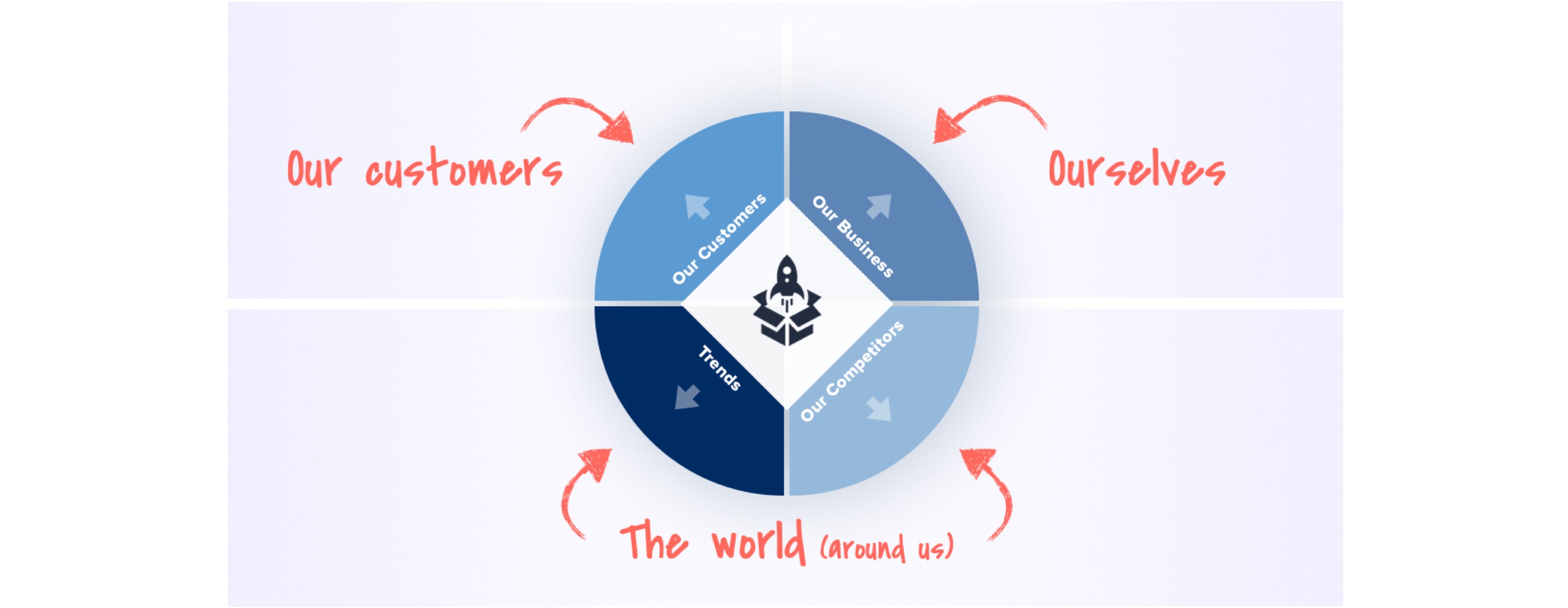
我们需要我们的客户的理解,邻urselves,和t 他的世界(我们周围)。 (We need an understanding of our customers, ourselves, and the world (around us).)
Our customers (or your clients customers)— Customer demographics, their goals, needs & drivers, their behaviors & preferences, etc…
我们的客户(或您的客户客户) -客户人口统计,他们的目标,需求和驱动因素,他们的行为和偏好等…
Ourselves (your company or client) — Mission, vision, strategy & goals, business model & revenue sources, products & services, etc…
我们自己(您的公司或客户) —使命,愿景,战略和目标,业务模型和收入来源,产品和服务等…
The world (around your company or client) — The competitive landscape, external forces & trends (industry trends, technology trends, changing customer preferences, etc…)
世界(围绕公司或客户) —竞争格局,外部力量和趋势(行业趋势,技术趋势,不断变化的客户喜好等)
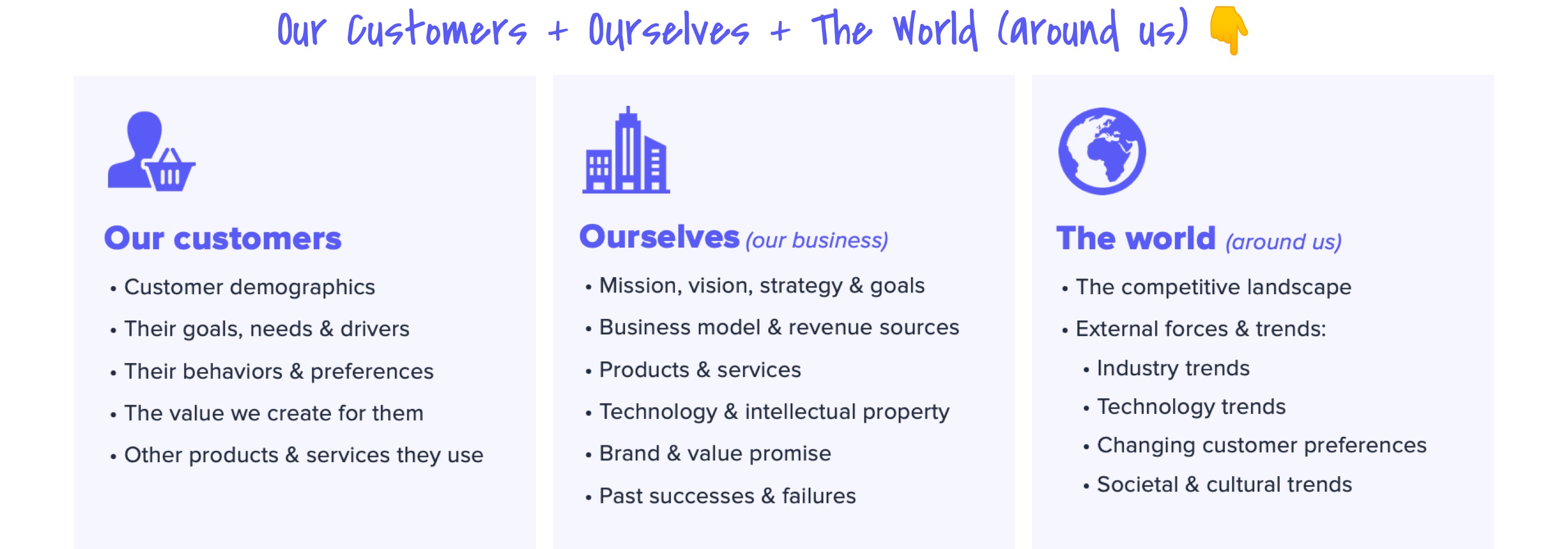
360°的理解涉及深入研究内部和外部景观的元素。 (A 360° understanding involves looking deeply at elements of both the internal and external landscape.)
Evaluating ourselves + other brands.
评估自己+其他品牌。
Internal: Ourselves — your company or client
内部:我们自己-您的公司或客户
External: Others — the competitive space
外部:其他-竞争空间

360°的理解使我们拥有促进影响力和一致性的知识。 (A 360° understanding empowers us with knowledge that fosters Impact and Alignment.)
A 360° understanding = Impact + Alignment
360°理解= 冲击 + 对齐

360°理解=影响。 (A 360° understanding = Impact.)
With a 360° understanding, we empower ourselves with the knowledge to develop significantly more impactful and differentiating human-centered design solutions.
有了360°的理解,我们就能凭借自己的知识来开发更具影响力和差异化的以人为本的设计解决方案。
这些知识使我们能够: (This knowledge empowers us to:)
Speak the language — Develop an informed perspective that speaks to both user needs and business drivers. Evangelize, discuss, and debate potential design solutions with context and clarity.
讲语言 -建立一个既能了解用户需求又能满足业务驱动力的明智见解。 在上下文和清晰的背景下传播,讨论和辩论潜在的设计解决方案。
Strive for differentiation — Avoid ‘me-too’ features and design beyond the status quo. Develop ideas that are aligned with the needs, pain points, and aspirations of our users.
力求差异化 —避免“ me-too”功能和设计超出现状。 提出与用户需求,痛点和期望相一致的想法。
360°理解=对齐。 (A 360° understanding = Alignment.)
With a 360° understanding, we empower ourselves to be more strategic by aligning design thinking and decision-making with the needs, goals and priorities of the business.
通过360°理解,我们使设计思维和决策与业务的需求,目标和优先事项保持一致,从而使自己更具战略性。
这种一致性促进了与以下方面的更牢固的伙伴关系: (This alignment fosters stronger partnerships with:)
- Customers & end-users 客户和最终用户
- Business leadership & executives 业务领导和高管
- Product management 产品管理
- Engineering 工程
- Sales & marketing 销售与市场营销
- Others within your organization 组织中的其他人

形成360°理解。 (Forming a 360° understanding.)
We can understand a company, product or service using Analysis Variables.
我们可以使用分析变量来了解公司,产品或服务。
分析变量可用于了解我们自己(内部)和其他公司(外部) 。 (Analysis Variables can be utilized to understand ourselves (internal) and other companies (external).)
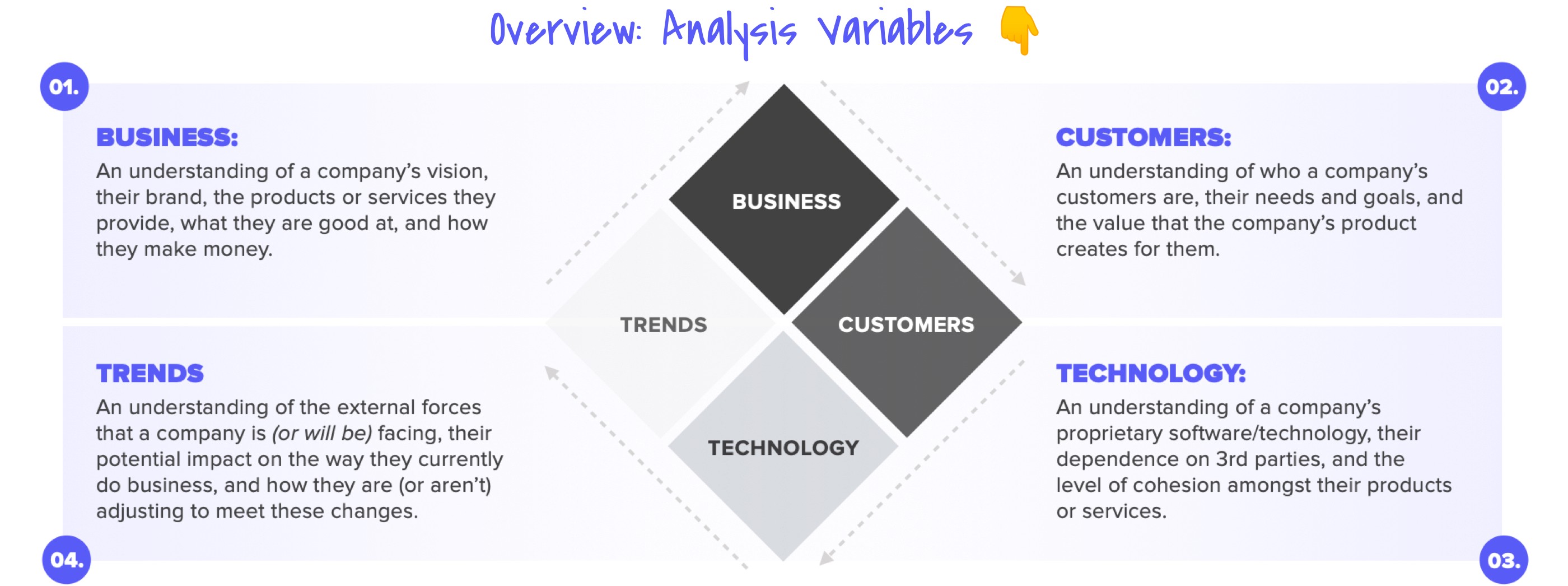
这四个变量的输出将使我们对公司,产品或服务有透彻的了解。 (The output of these four Variables will provide us with a thorough understanding of a company, product or service.)
Business + Customers + Technology + Trends.
业务+客户+技术+趋势。
01: Business — A company’s vision, their brand, the products or services they provide, what they are good at, and how they make money.
01:业务 —公司的愿景,品牌,提供的产品或服务,擅长的领域以及赚钱的方式。
02: Customers — Who a company’s customers are, their needs and goals, and the value that the company’s product creates for them.
02:客户 —公司客户的身份,他们的需求和目标以及公司产品为他们创造的价值。
03: Technology — A company’s proprietary software/technology, their dependence on 3rd parties, and the level of cohesion amongst their products or services.
03:技术 —公司的专有软件/技术,对第三方的依赖以及产品或服务之间的凝聚力水平。
04: Trends — The external forces that a company is (or will be) facing, their potential impact on the way they currently do business, and how they are (or aren’t) adjusting to meet these changes.
04:趋势 -公司正在(或将要)面临的外部力量,它们对当前开展业务方式的潜在影响以及如何(或不)进行调整以适应这些变化。
通过对多家公司(和我们自己)的分析,我们可以更好地了解环境并获得360度的了解。 (Through an analysis of multiple companies (and ourselves), we can better understand the landscape and gain a 360° understanding.)
After using Analysis Variables to understand ourselves, other companies, and the world around us, we can use our insights and newly found understanding of the landscape to formulate a 360° understanding.
在使用分析变量了解自己,其他公司以及我们周围的世界之后,我们可以使用我们的洞察力和新发现的对地形的理解来形成360°的理解。


进行分析。 (Conducting an analysis.)
Analysis Variables can be used to guide our analysis.
分析变量可用于指导我们的分析。

对于每个变量,我们都可以使用分析技术。 (For each variable, there are analysis techniques that we can utilize.)
Some are good for internal analysis, others for external — some can be executed independently, others require the participation of others.
有些适合内部分析,有些适合外部分析-有些可以独立执行,有些需要其他人的参与。


分析变量01-分析业务。 (Analysis Variable 01 — analyzing a business.)
Analyzing a business will help us understand a company’s vision, their brand values and positioning, the products or services they provide, what they are good at, and how they make money.
分析业务将帮助我们了解公司的愿景,品牌价值和定位,提供的产品或服务,擅长的领域以及赚钱的方式。
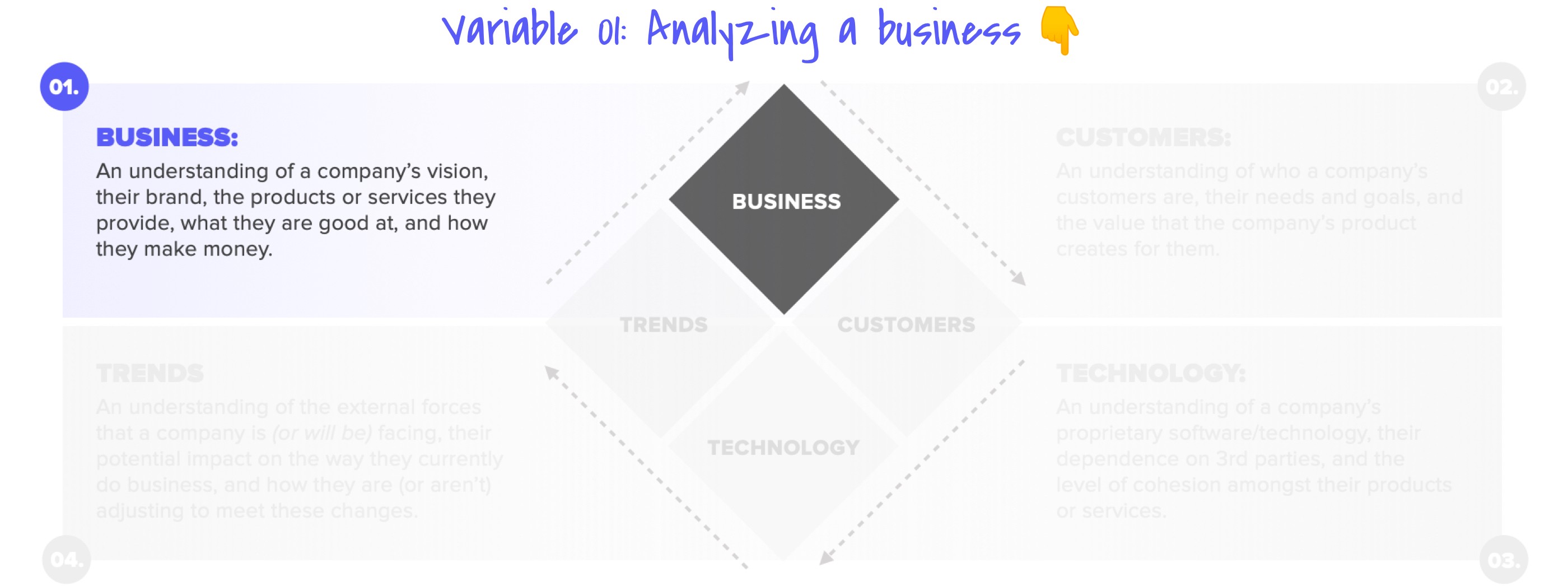
分析业务时,我们可以专注于公司,公司的一项或多项产品和服务,或两者兼而有之。 (When analyzing a business, we can focus on a company, one or more of its products & services, or both.)

分析公司。 (Analyzing a company.)
By analyzing a company, we can understand their vision, brand and value promise, their business model, how they make money, and where they have been successful and fell short in the past.
通过分析公司,我们可以了解他们的愿景,品牌和价值承诺,他们的商业模式,他们如何赚钱以及他们过去成功的地方和失败的地方。
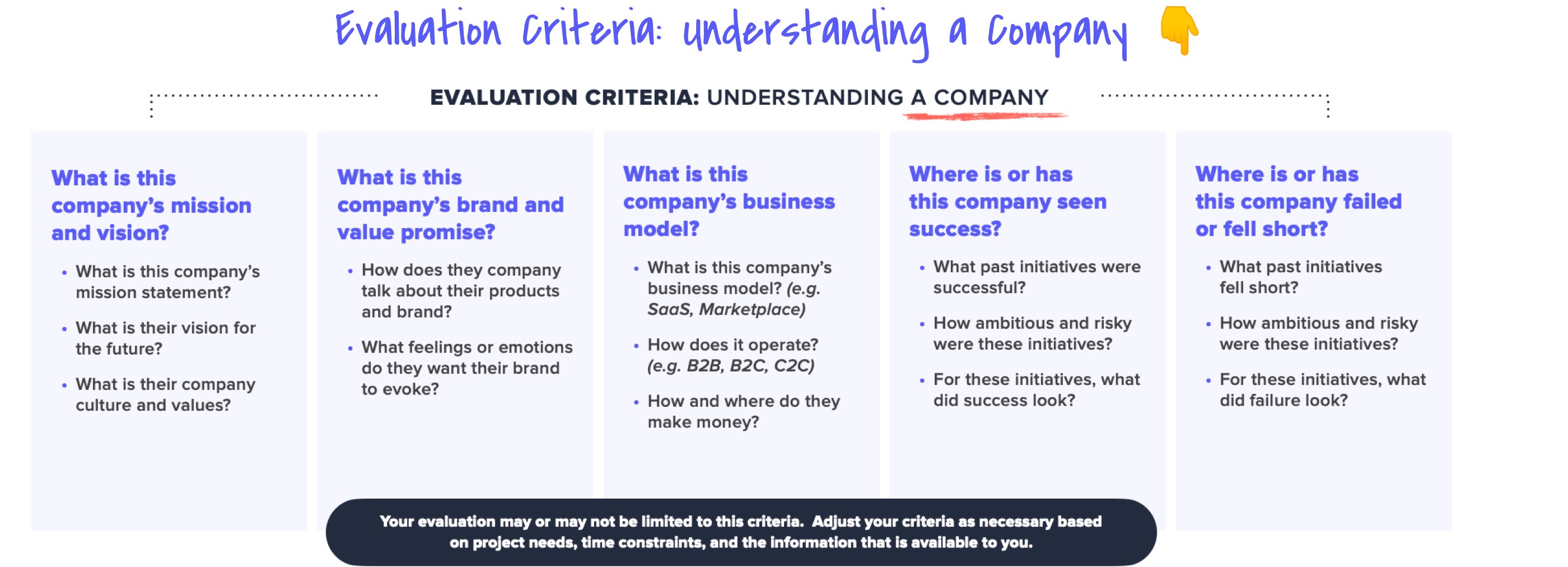
分析公司的产品。 (Analyzing a company’s products.)
By analyzing a company’s products, we can understand the products or services they provide, how they fit into a larger portfolio, their selling points and market positioning, future aspirations, and their competition.
通过分析公司的产品,我们可以了解他们提供的产品或服务,它们如何适合更大的产品组合,它们的卖点和市场定位,未来的抱负以及竞争。
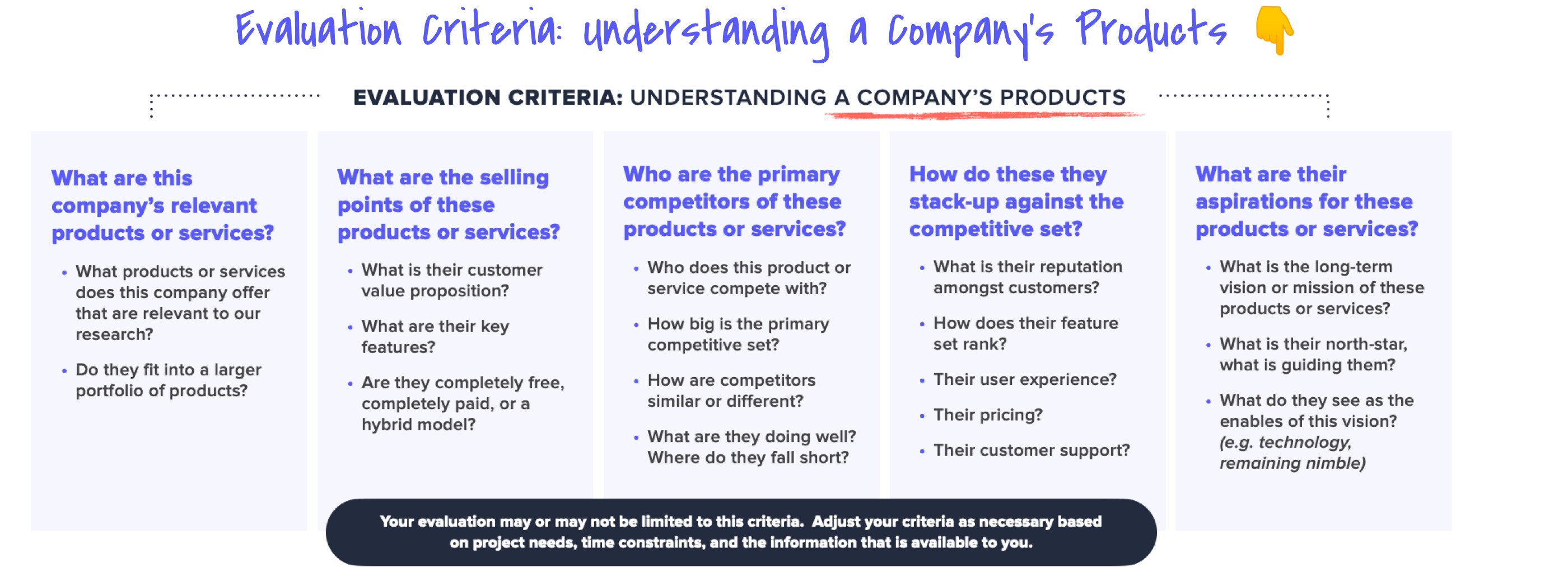
要分析公司及其产品和服务,我们可以采用多种工具和技术。 (To analyze a company and its products & services, we can employ a variety of tools and techniques.)
Some are good for internal analysis, others for external — some can be executed independently, others require the participation of others.
有些适合内部分析,有些适合外部分析-有些可以独立执行,有些需要其他人的参与。
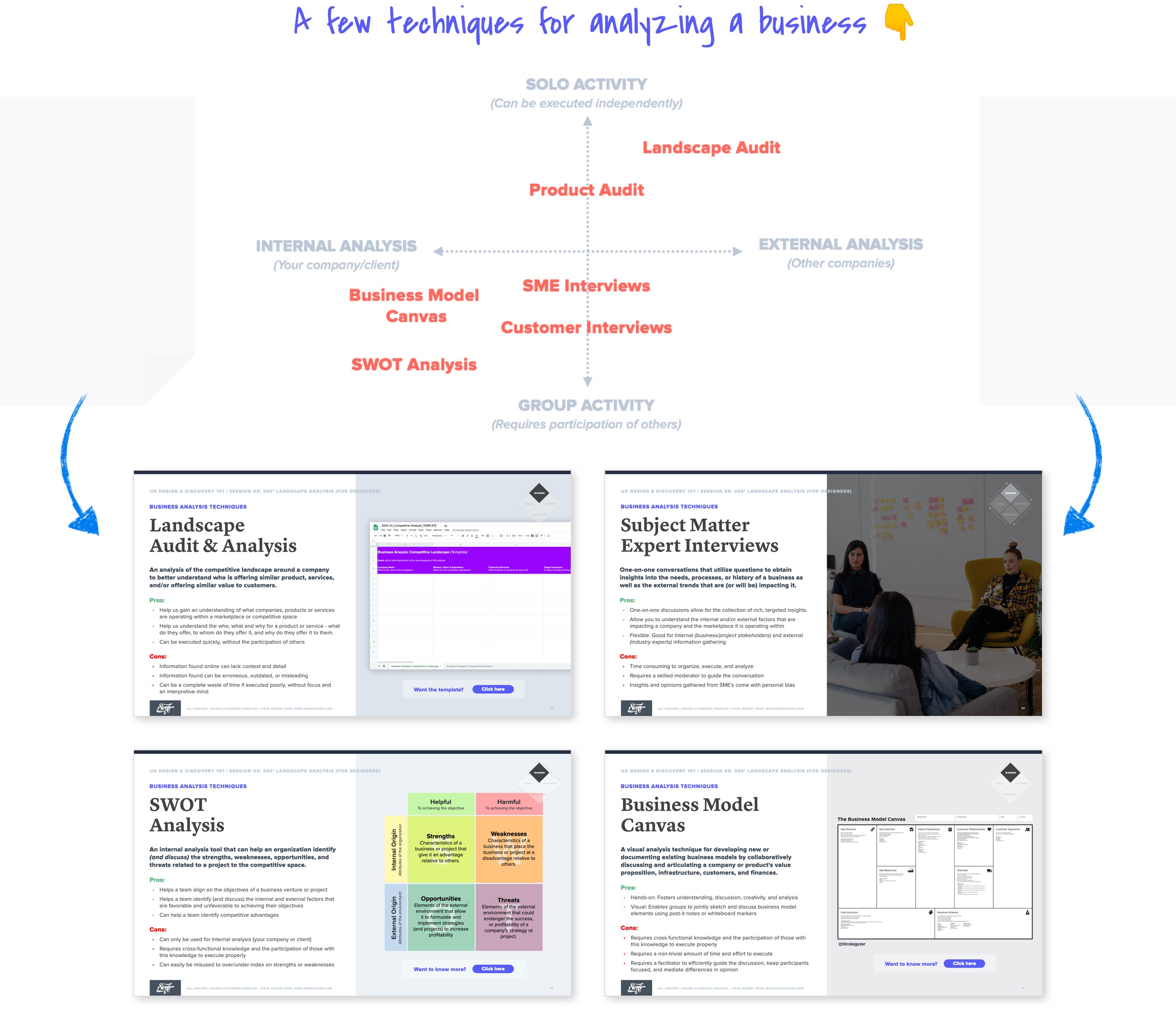
但是,在开始进行分析之前,我们需要了解业务模型的基础。 (However, before getting started with our analysis, we need to understand the basics of Business Models.)
A business model is a company’s plan for making a profit. It identifies the products or services the business will sell, the target market it has identified, and the expenses associates with operating.
商业模式是公司的获利计划。 它确定企业将要出售的产品或服务,确定的目标市场以及与运营相关的费用。
What is being sold — The products or services this business offer to its customers.
正在出售的产品-该企业向其客户提供的产品或服务。
Who it is being sold to — The target customers of the products or services the company offers.
将其出售给谁 —公司提供的产品或服务的目标客户。
Operational expenses — The costs associated with the company’s business operations.
运营支出 -与公司业务运营相关的成本。
在进行分析以获取360°理解时,我们主要关注与公司价值主张相关的业务模型方面。 (When analyzing to gain a 360° understanding, we are primarily concerned with the aspects of the Business Model that speak to a company’s Value Proposition.)

要了解公司的商业模式,包括其价值主张,我们可以从回答五个问题开始。 (To understand a company’s Business Model, including their Value Proposition, we can start by answering five questions.)

要回答这五个问题,我们需要了解企业的基本知识及其运作方式。 (To answer these five questions, we need to understand the basics of a business and how they operate.)
In most cases, to answer these five questions and understand a company, we can analyze publicly available information.
在大多数情况下,要回答这五个问题并了解一家公司,我们可以分析公开可用的信息。
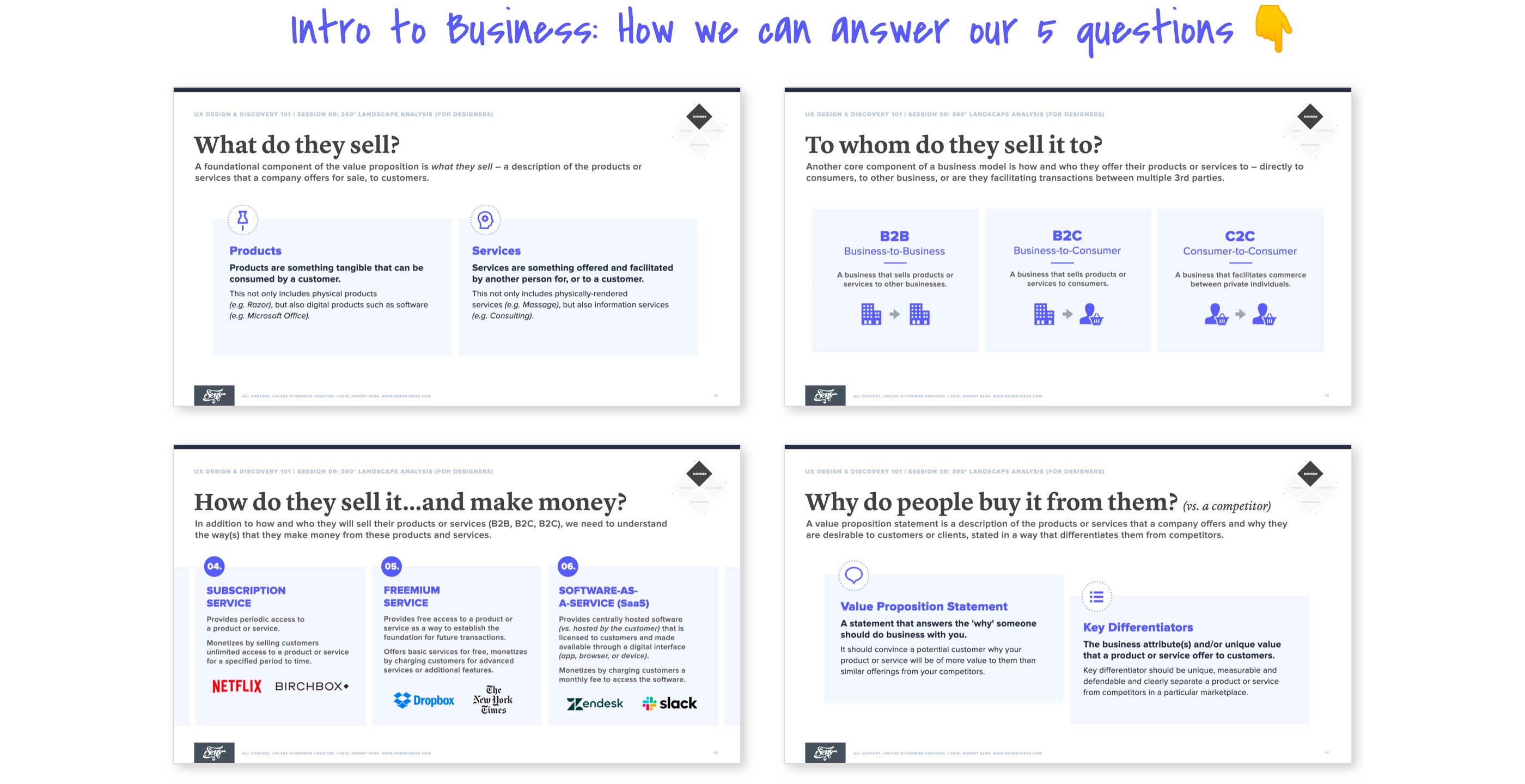

分析变量02-分析客户。 (Analysis Variable 02 — analyzing customers.)
Analyzing customers will help us understand who a company’s customers are, their needs & goals, how they behave, the value that a company’s product creates for them, and other similar products or services that they utilize.
分析客户将帮助我们了解公司的客户是谁,他们的需求和目标,他们的行为方式,公司产品为他们创造的价值以及他们使用的其他类似产品或服务。
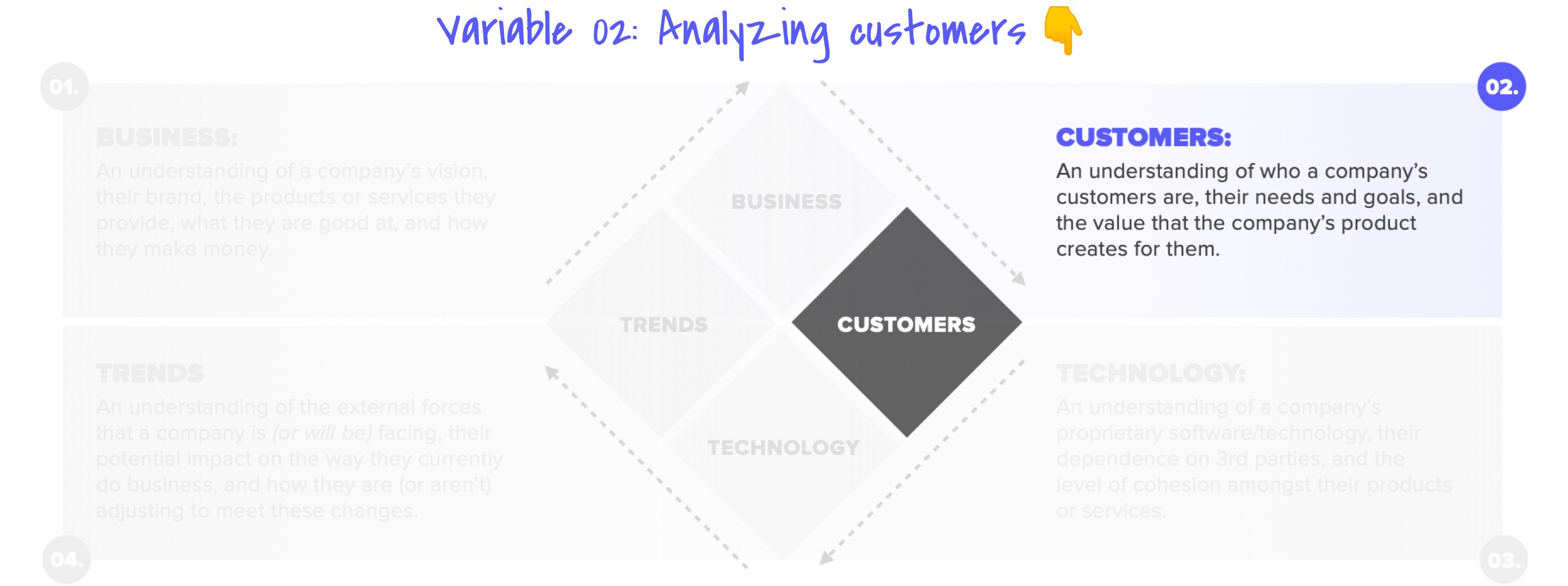
分析公司的客户。 (Analyzing a company’s customers.)
By analyzing a company’s customers, we can understand what types of customer they are targeting and why.
通过分析公司的客户,我们可以了解他们针对的客户类型以及原因。
Additionally, we can gain an understanding of why customers use the company’s products — including what needs the company’s products are helping them fulfill, how they interact with the product, what value they obtain from using the product, and what (if any) other products they use to fulfill similar needs.
此外,我们还可以了解客户为何使用公司的产品-包括公司的产品正在帮助他们满足哪些需求,他们如何与产品互动,从使用产品中获得什么价值以及什么(如果有)其他产品。他们用来满足类似的需求。
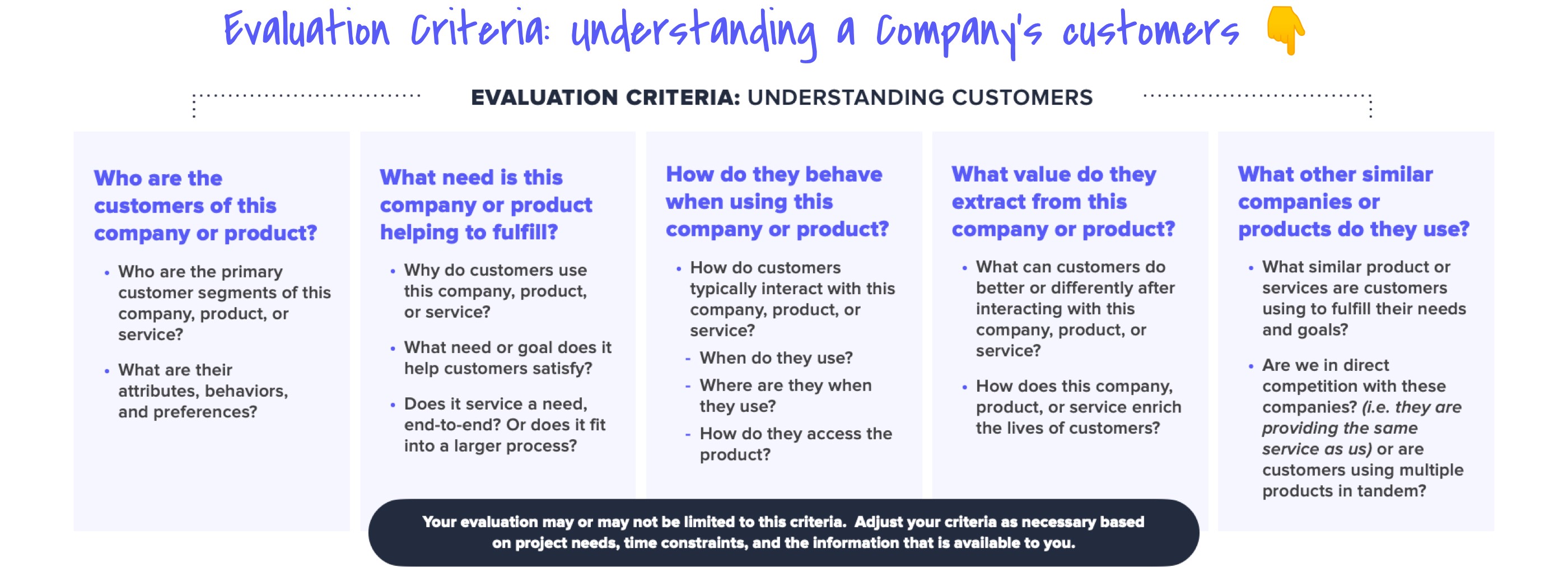
要分析公司的客户,我们可以采用多种工具和技术。 (To analyze a company’s customers, we can employ a variety of tools and techniques.)
Some are good for internal analysis, others for external — some can be executed independently, others require the participation of others.
有些适合内部分析,有些适合外部分析-有些可以独立执行,有些需要其他人的参与。
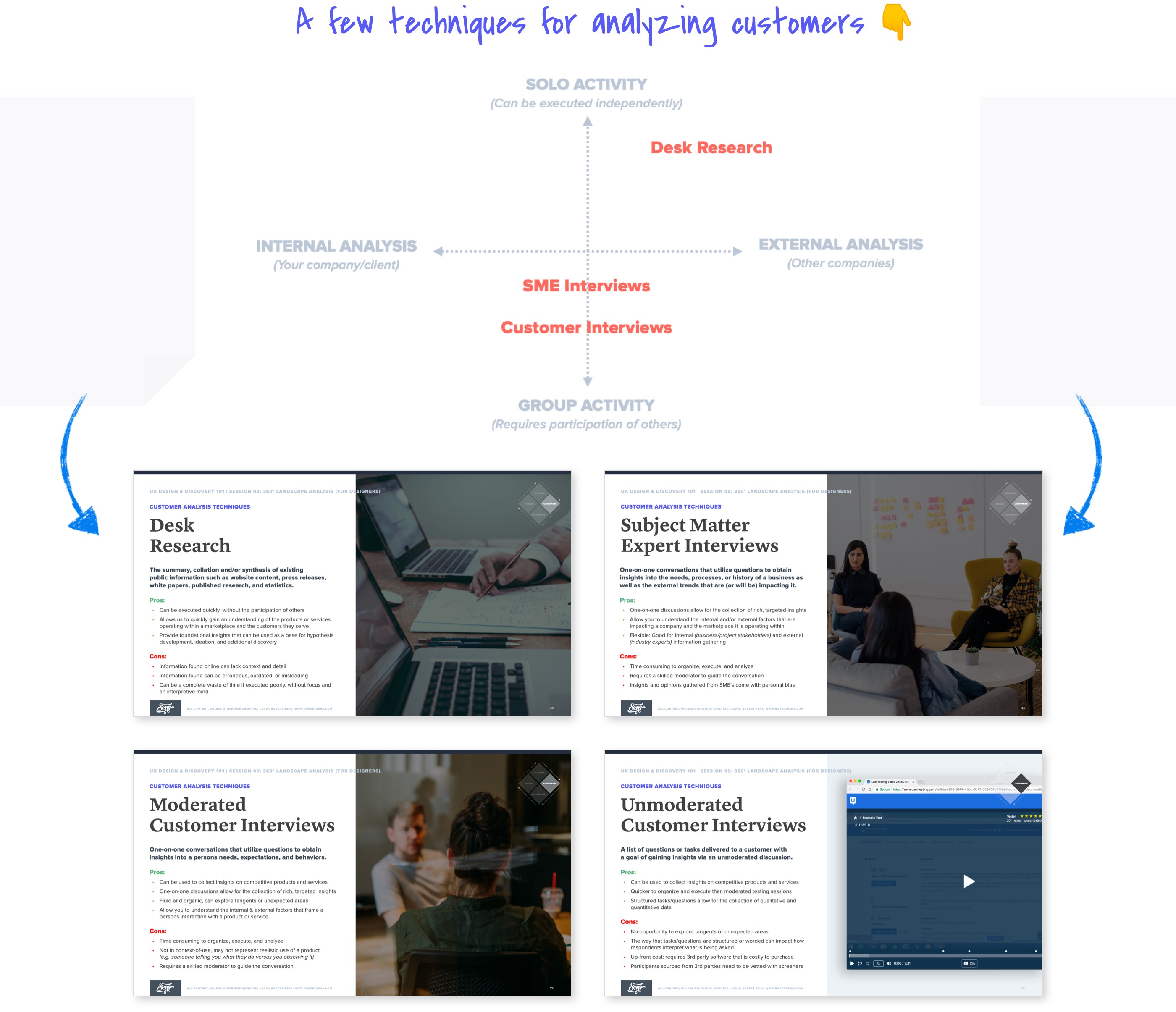
但是,在开始进行分析之前,我们需要了解客户群的基础。 (However, before getting started with our analysis, we need to understand the basics of Customer Segments.)
Customer Segments are sub-groups of customers, segmented by some type of shared characteristics, that a product or service has identified as being most likely to have high growth and profit potential.
客户群是按某种共有特征细分的客户子群,产品或服务已被确定为最有可能具有高增长和潜在利润。
Geographic — Country, city area/region, population, etc…
地理 -国家,城市地区/区域,人口等…
Demographic — Age, gender, income, life stage, etc…
人口特性 -年龄,性别,收入,生活阶段等…
Behavioral — Intent, usage, benefits sought, buyer stage, etc…
行为 -意图,用法,寻求的利益,购买者阶段等…
Psychographic — Lifestyle, activities/interests/opinions (AIO), values, attitudes, etc…
心理记录 -生活方式,活动/兴趣/意见(AIO),价值观,态度等…

公司的商业模式,包括他们销售的产品和销售方式,通常会对他们选择细分客户的方式产生重大影响。 (A company’s business model, including the products they sell and the way they sell them, typically has a significant impact on the way that they choose to segment their customers.)
- Business-to-business (B2B) sellers might segment the market into different types of businesses or by countries/regions. 企业对企业(B2B)卖方可能会将市场划分为不同类型的企业或按国家/地区划分。
- Business-to-consumer (B2C) sellers might segment the market into demographic, lifestyle or behavioral segments. 企业对消费者(B2C)卖家可能会将市场细分为人口,生活方式或行为细分。

单个碱基通常用于细分。 但是,可以将某些碱基合并为一个细分(小心)。 (A single base is typically used for segmentation. However, some bases can be combined into a single segmentation (with care).)
For example, geographics and demographics (geo-demographic) are often combined, but others combinations are less common.
例如,地理和人口统计(地域人口统计)通常会组合在一起,但其他组合则不太常见。


分析变量03-分析技术。 (Analysis Variable 03 — analyzing technology.)
Analyzing technology will help us understand a company’s software and technology prowess, their dependence on 3rd parties, the level of cohesion amongst their products, and if technology roadblocks or efficiencies exist within the company.
分析技术将帮助我们了解公司的软件和技术实力,他们对第三方的依赖,产品之间的凝聚力以及公司内是否存在技术障碍或效率。
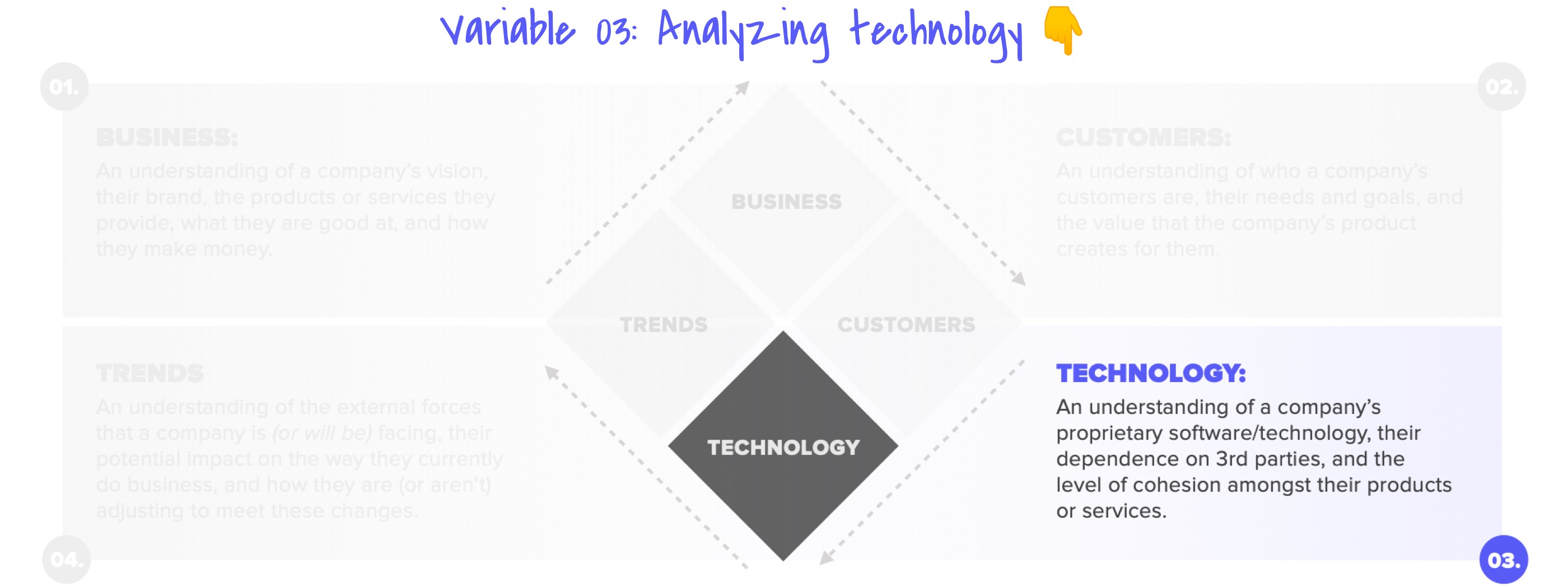
分析公司的技术。 (Analyzing a company’s technology.)
By analyzing a company’s technology, we can understand how well suited they are to be able to build digital products and services.
通过分析公司的技术,我们可以了解他们对于构建数字产品和服务的适合程度。
The most common factors that can influence a company’s ability to build digital products and services include their history and relationship with technology (how embedded is technology in their DNA?), how dependent they are on 3rd party technology providers, the existing level of cohesion amongst their product’s technology, and the roadblocks or efficiencies that exist as a result of this level of cohesion.
影响公司构建数字产品和服务能力的最常见因素包括其历史和与技术的关系(技术在其DNA中的嵌入程度如何) ,它们对第三方技术提供商的依赖程度,现有的凝聚力水平他们产品的技术,以及由于这种凝聚力而存在的障碍或效率。
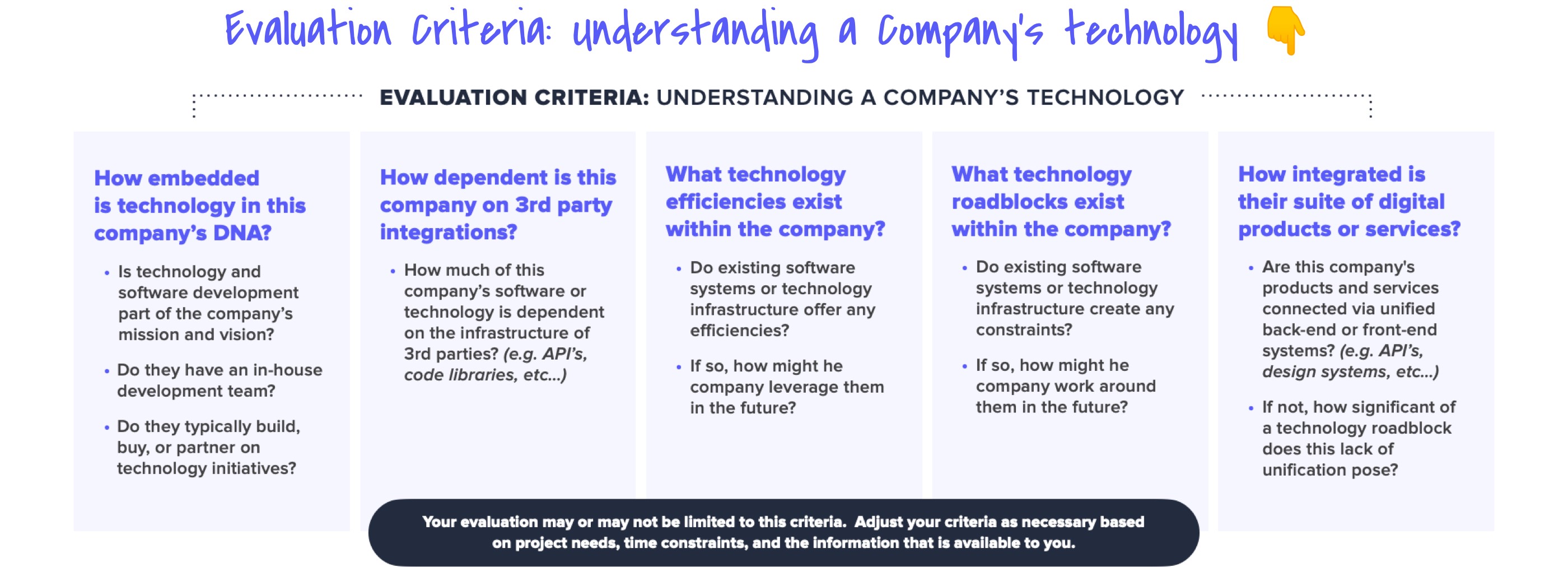
要分析公司的技术,我们可以采用一些不同的工具和技术。 (To analyze a company’s technology, we can employ a few different tools and techniques.)
Some are good for internal analysis, others for external — some can be executed independently, others require the participation of others.
有些适合内部分析,有些适合外部分析-有些可以独立执行,有些需要其他人的参与。
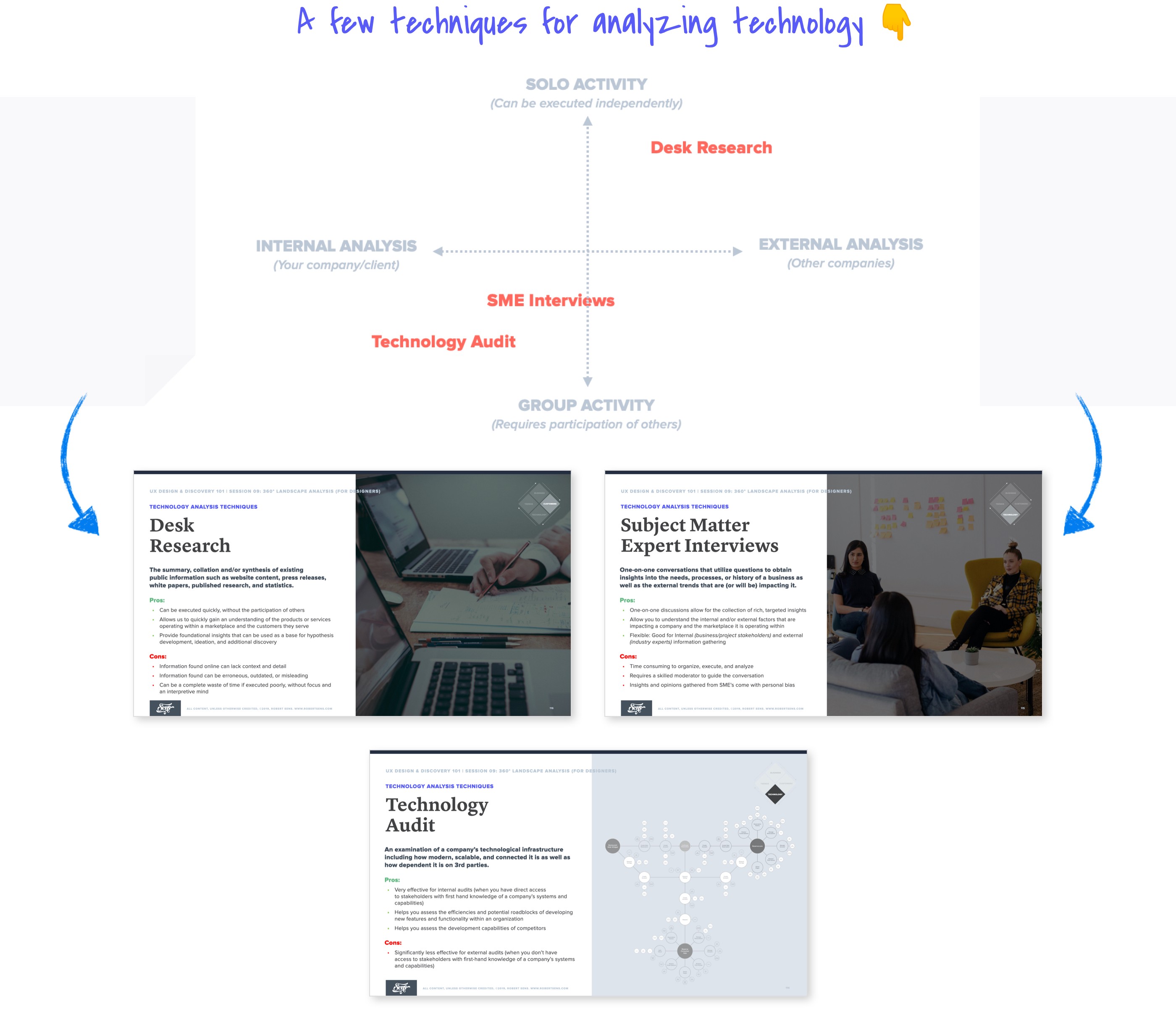
分析公司的技术基础结构时,重要的是要考虑三个变量。 (When analyzing a companies technological infrastructure, it is important to consider three variables.)
Existing infrastructure — How modern, scalable, and connected is the company’s technological infrastructure?
现有的基础架构 -公司的技术基础架构如何现代化,可扩展和相互连接?
Dependency on others — How dependent is the company on 3rd party software to power their existing infrastructure?
对他人的依赖-公司对第三方软件的依赖程度如何,以支持其现有基础架构?
Ability to build — Is the company capable of building software internally to power their own infrastructure?
构建能力 -公司是否有能力在内部构建软件以为其自身的基础架构提供动力?


分析变量04-分析趋势。 (Analysis Variable 04 — analyzing trends.)
Evaluating trends will help us understand the external forces that a company is (or will be) facing, their potential impact on the way they currently do business, and how they are (or aren’t) adjusting to meet these changes.
评估趋势将有助于我们了解公司正在(或将要面临)的外部力量,它们对当前经营方式的潜在影响以及如何(或不)进行调整以适应这些变化。
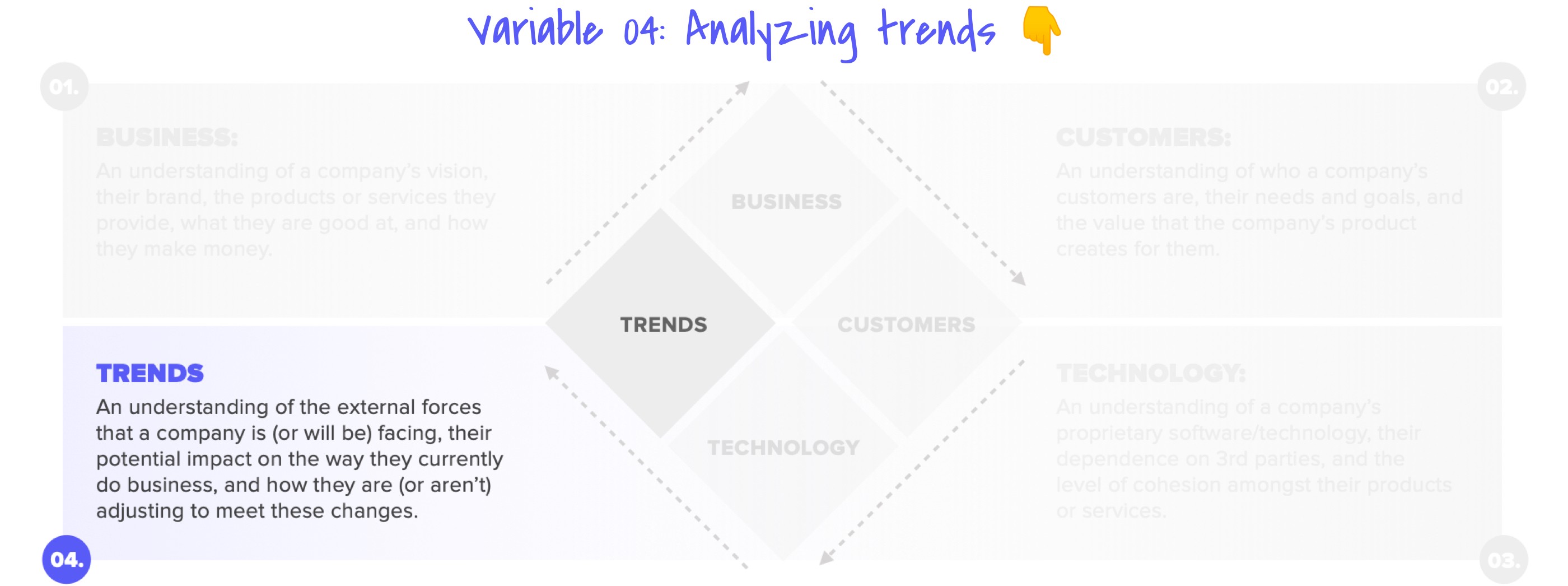
分析影响公司的趋势和外部力量。 (Analyzing the trends & external forces impacting a company.)
By analyzing trends and external forces, we can understand the headwinds that a company is (or will be) facing and how they could, are, or aren’t adjusting to meet these changes.
通过分析趋势和外部力量,我们可以了解公司正在(或将要面对)的不利因素以及它们如何,正在或不能够适应这些变化。
To gain an understanding of the external forces, we need to analyze external trends and upstart competitors, the risks they pose to a company, and what (if any) actions the company is taking to address these risks.
为了了解外部力量,我们需要分析外部趋势和新贵竞争对手,竞争对手给公司带来的风险以及公司为应对这些风险所采取的行动(如果有) 。
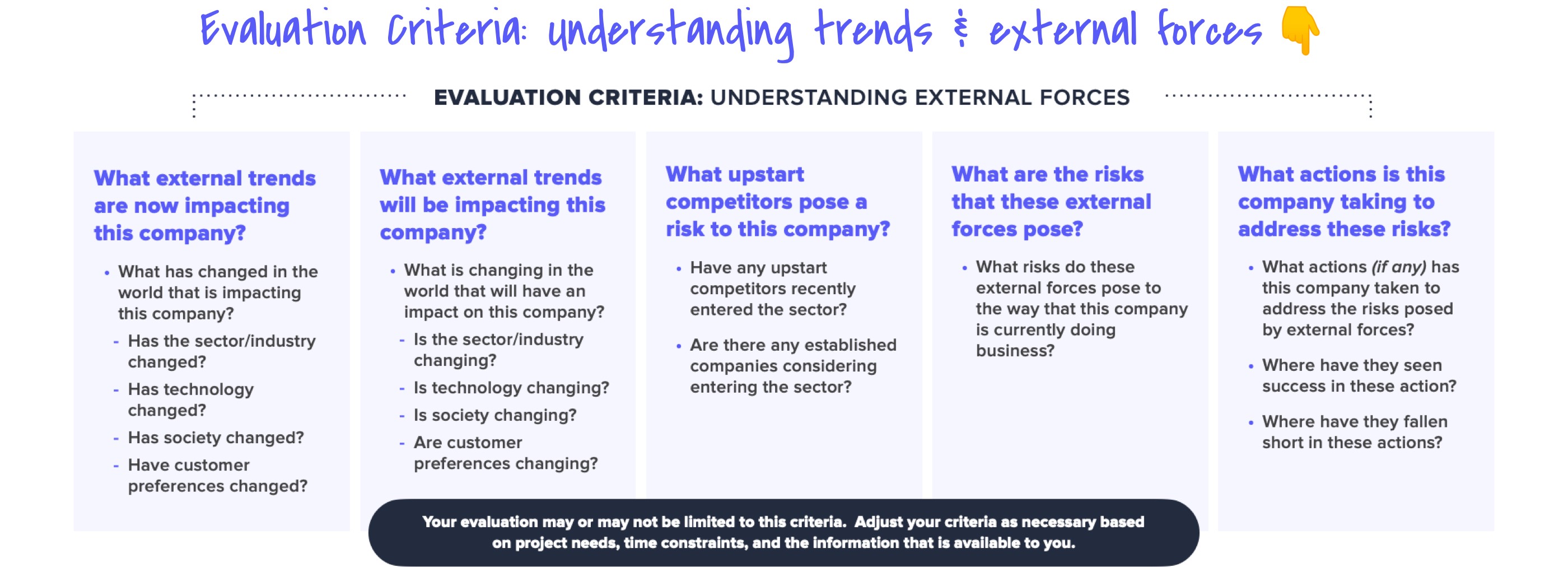
为了分析影响公司的趋势和外部力量,我们可以采用一些不同的工具和技术。 (To analyze the trends & external forces impacting a company, we can employ a few different tools and techniques.)
Some are good for internal analysis, others for external — some can be executed independently, others require the participation of others.
有些适合内部分析,有些适合外部分析-有些可以独立执行,有些需要其他人的参与。
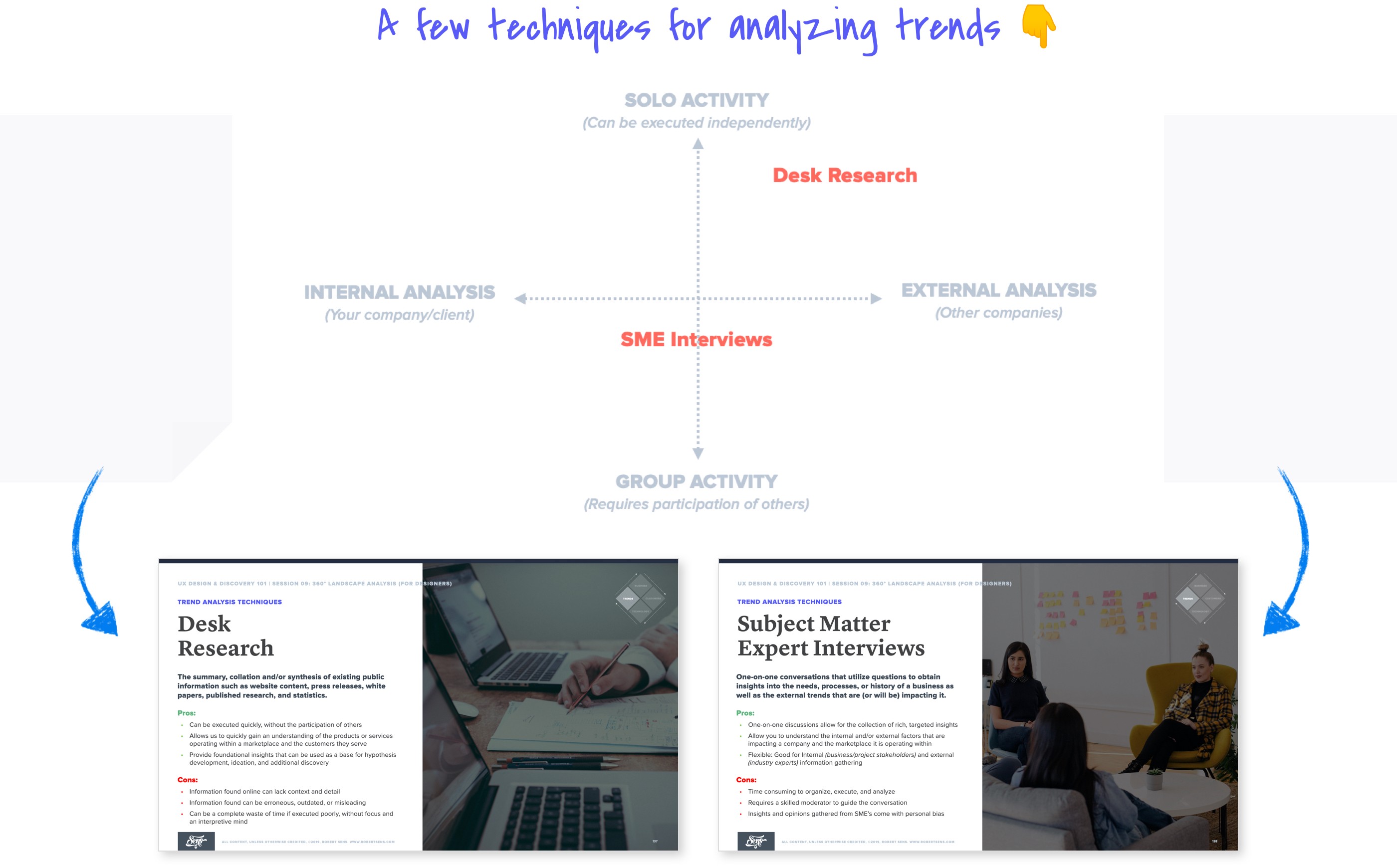
行业,技术和社会是影响产品或服务的最常见外部趋势类型。 (Industry, technology and societal are the most common types of external trends that impact a product or service.)
Industry trends — Changes impacting an industry, sector, or market.
行业趋势 -影响行业,行业或市场的变化。
Technology trends—Changes in technology and human-computer interaction.
技术趋势 -技术和人机交互的变化。
Societal trends—Trends in human behavior, perception, or expectations.
社会趋势 -人类行为,感知或期望的趋势。

来自行业领导者的白皮书通常是有关行业趋势的绝佳信息来源。 (White papers from industry leaders are often excellent sources of information on industry trends.)
Companies, consultancies and agencies are continuously publishing white papers and articles on the trends impacting industry sectors. These types of resources provide a wealth of free information.
公司,咨询公司和代理商不断发布有关影响行业的趋势的白皮书和文章。 这些类型的资源提供了大量的免费信息。
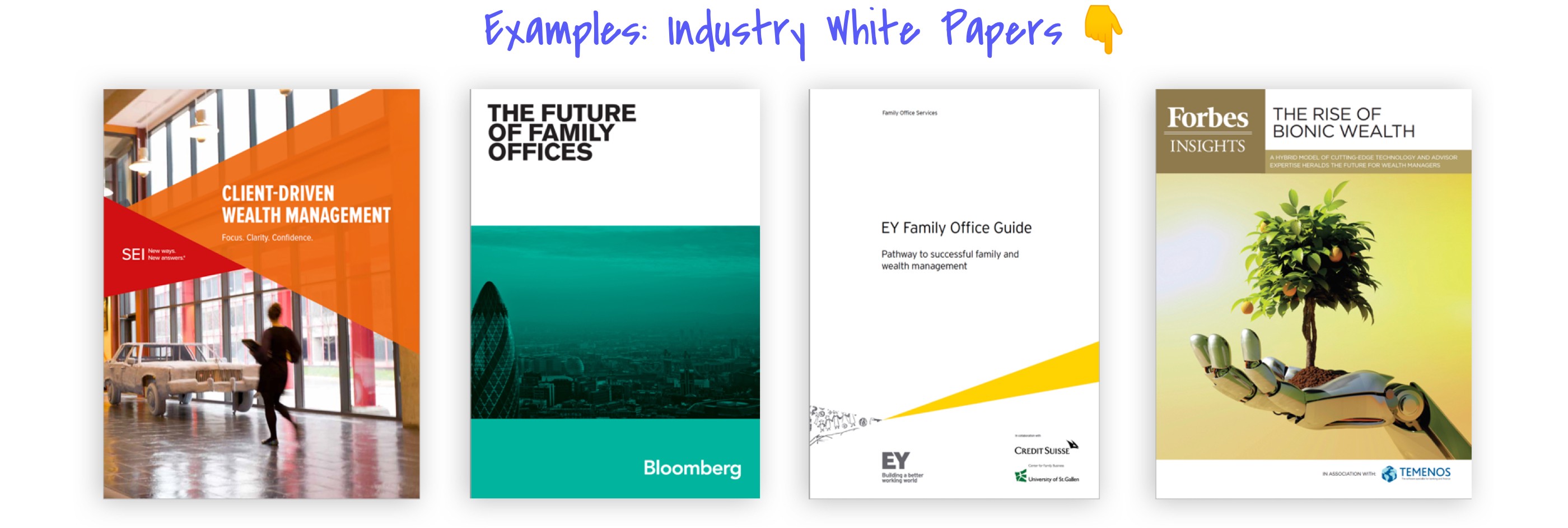
设计机构和创新咨询公司的年度趋势报告是有关技术和社会趋势的绝佳信息来源。 (Annual trend reports from design agencies and innovation consultancies are excellent sources of information on technology & societal trends.)
Each year, agencies and innovation consultancies like Fjord and frog publish their take on the technological and societal shifts impacting their clients. These types of resources provide a wealth of free information.
每年,诸如峡湾和青蛙之类的代理机构和创新咨询公司都会发布影响客户的技术和社会变革报告。 这些类型的资源提供了大量的免费信息。


本次会议如何安排和促进? (How is this session structured & facilitated?)
This session is a mix of theory and short, hands-on activities that enable participants to apply concepts in real-time.
本次会议结合了理论和简短的动手操作,使参与者能够实时应用概念。
Participants are first walked through the value of having a 360° understanding, what it entails, and the four Analysis Variables that can be used to establish a 360° understanding. They are then walked through each variable individually and introduced to what they need to know before they get started, analysis techniques they can utilize, and a real-world example of how they can start small to get an analysis up and running quickly.
首先,参与者了解了对360°理解的价值,所包含的内容以及可用于建立360°理解的四个分析变量。 然后,他们分别浏览每个变量,并向他们介绍开始之前需要了解的知识,可以利用的分析技术以及如何从小处着手以快速启动分析和运行的真实示例。
Throughout the session, several short, hands-on exercises are used to reinforce the content.
在整个会话中,将使用一些简短的动手练习来增强内容。
The facilitator deck & exercise structure can be reviewed below. 👇👇🏼👇🏾
主持人平台和练习结构可以在下面进行审查。 👇👇🏼👇🏾

您如何在本课程中执行练习? (How can you execute the exercises in this lesson?)
There are four medium length, participatory exercises intertwined within the content of this session — each exercise builds upon the previous one, resulting in a lightweight analysis of a company.
在本次会议的内容中,有四个中等长度的参与性练习相互交织-每个练习都是在前一个练习的基础上进行的,从而对公司进行了轻量级的分析。
选择公司。 (Choosing a company.)
At the beginning of this session, participants are asked to choose a company to focus on and use throughout the four exercises. To keep things simple, I provide participants with a list of 6 companies whose product offerings are not overly complex and have plenty of information available online.
在本节开始时,要求参与者选择一家公司,以集中精力并使用这四个练习。 为简单起见,我为参加者提供了6家公司的列表,这些公司的产品提供并不太复杂,可以在线获取大量信息。


练习01- 分析一家公司。 (20分钟) (Exercise 01 — analyzing a company. (20 mins))
The goal of this exercise is to practice starting small and getting up and running quickly by conducting a simple analysis of a company using information available on the internet.
该练习的目的是通过使用Internet上可用的信息对公司进行简单分析,练习从小规模起步,快速起步并快速运行。
In this exercise, participants are asked to analyze and identify the key attributes of a company (chosen from the list provided) using information available on the internet. To guide their analysis, they are provided a sample analysis goal and an evaluation criteria consisting of five questions.
在本练习中,要求参与者使用Internet上可用的信息来分析和识别公司的关键属性(从提供的列表中选择) 。 为了指导他们的分析,向他们提供了一个样本分析目标和一个包含五个问题的评估标准。
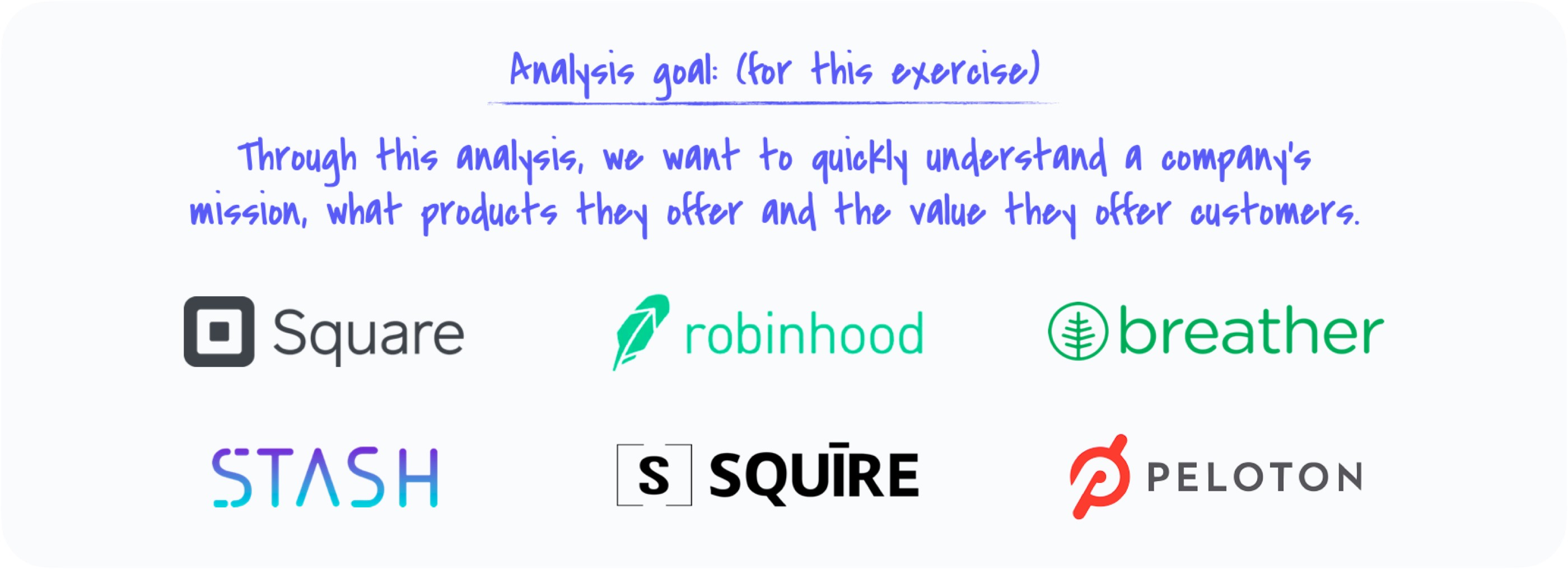
练习01:格式。 (Exercise 01: Format.)
After providing participants with an overview of Analysis Variable 01 (analyzing a business) and walking them through a real-world example of how they can start small to get up and running quickly, ask participants to practice conducting their own lightweight analysis.
向参与者提供了分析变量01的概述(分析业务)并向他们展示了如何从小处着手以快速启动并运行的真实示例之后,请参与者练习进行自己的轻量级分析。
Using the sample Analysis Goal (above) and Evaluation Criteria (below), prompt participants to search the internet for information that can provide insights into the companies they have chosen from the list provided.
使用样本分析目标(上方)和评估标准(下方) ,提示参与者在互联网上搜索信息,这些信息可以深入了解他们从提供的列表中选择的公司。
Pro-tip: Have participants start their search on the company’s ‘About’ page, usually a link in the footer of their website.
专家提示:让参加者在公司的“关于”页面上开始搜索,通常在其网站页脚中有一个链接。
- As they find information that is relevant to the five questions in the evaluation criteria, instruct them to take screenshots and write down key points on a piece of paper or post-it notes. 当他们找到与评估标准中的五个问题相关的信息时,请他们进行屏幕截图并将要点记录在一张纸或便签纸上。
- As they search, encourage them to also write down any questions they have about the company that arise from the information they find. Getting into this habit will help them practice critical thinking and analyzing the information they find beyond a surface level. 当他们搜索时,鼓励他们也写下他们从发现的信息中对公司的任何疑问。 养成这种习惯将帮助他们练习批判性思维,并分析他们从表面上发现的信息。

练习01:总结。 (Exercise 01: Wrapping-up.)
After the exercise, prompt participants to spend a few minutes sharing what they learned from conducting their analysis and what (if anything) was challenging about finding and analyzing information found on the internet.
练习后,提示参与者花几分钟时间分享他们从进行分析中学到的知识,以及在查找和分析在互联网上找到的信息时面临的挑战(如果有的话) 。

练习02 —我确定客户。 (15分钟) (Exercise 02— identifying customers. (15 mins))
This exercise builds upon the previous exercise, its goal is to practice starting small and getting up and running quickly by conducting a simple analysis of who a company’s target customer(s) are using information available on the internet and the insights discovered in activity 01.
本练习是在上一个练习的基础上进行的,其目标是通过使用网络上的可用信息以及在活动01中发现的见解进行简单分析,以练习从小处着手并快速启动并运行。
In this exercise, participants are asked to identify the target customer segment(s) of the company they analyzed in activity 01. To guide their analysis, they are provided a sample analysis goal and an evaluation criteria that builds upon the questions from the previous activity (see below).
在本练习中,要求参与者确定他们在活动01中分析的公司的目标客户群。为指导他们的分析,将为他们提供一个样本分析目标和一个基于先前活动的问题的评估标准。 (请参见下文) 。
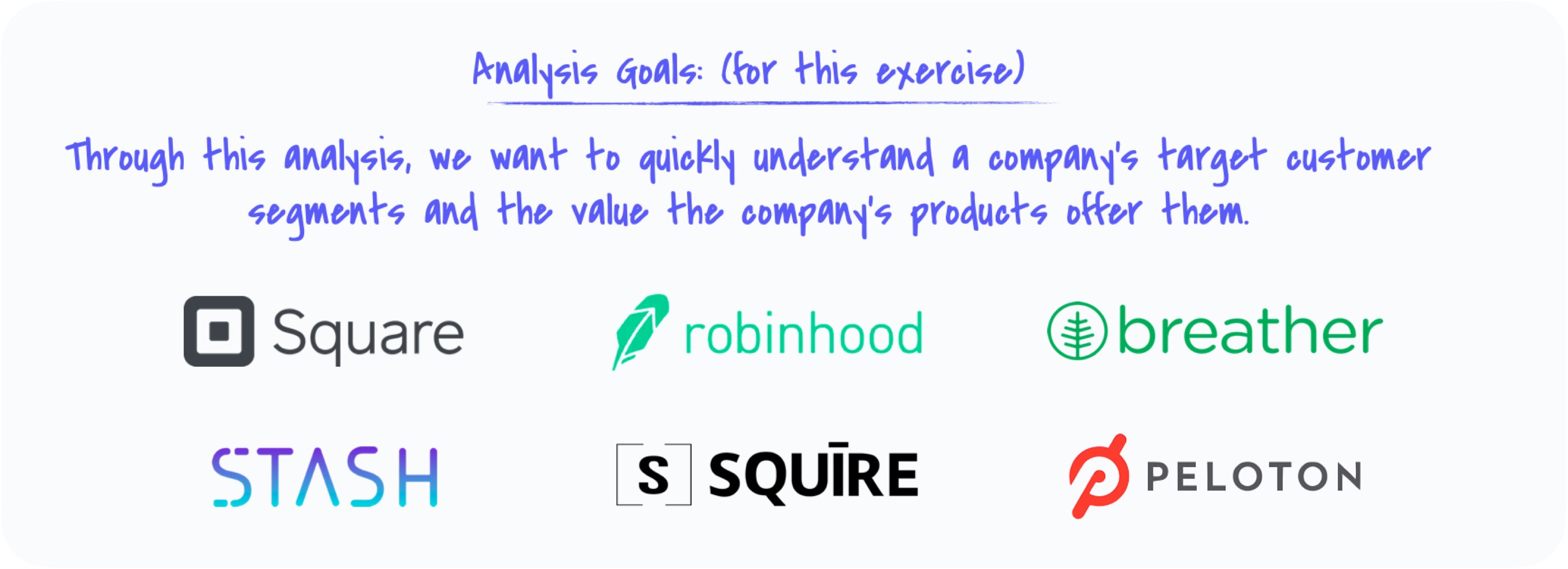
练习2:格式。 (Exercise 2: Format.)
After providing participants with an overview of Analysis Variable 02 (analyzing customers) and walking them through a real-world example of how they can start small to get up and running quickly, ask participants to practice conducting their own lightweight analysis.
向参与者提供了Analysis Variable 02的概述(分析客户)并向他们展示了如何从小处着手以快速启动并运行的真实示例之后,请参与者练习进行自己的轻量级分析。
Using the sample analysis goal (above) and evaluation criteria (below), prompt participants to search the internet for information that can provide insights into the target customer segment(s) of the company you analyzed in activity 01.
使用样本分析目标(上方)和评估标准(下方) ,提示参与者在互联网上搜索信息,这些信息可以为您在活动01中分析的公司的目标客户群提供见解。
Pro-tip: Start by looking at your analysis from activity 01, you may already have the answers to these questions.
专家提示:首先查看活动01中的分析,您可能已经对这些问题有了答案。
- As they identify customer segments, have participants write each one on a separate post-it note. 当他们确定客户群时,请参与者在单独的便条纸上写下每个。
- After they have identified one or more customer segments, encourage participants to begin adding context to their segments. 在确定一个或多个客户细分之后,鼓励参与者开始向其细分添加上下文。
- To facilitate this, prompt participants with provocations — Why are they targeting these customers? What customer needs are their products fulfilling? Which segments are their primary target? Which are secondary or tertiary? Why? 为方便起见,请挑衅的参与者Swift挑衅-他们为什么要针对这些客户? 他们的产品满足了哪些客户需求? 他们的主要目标是哪些细分市场? 哪些是中学或高等教育的? 为什么?

练习2:总结。 (Exercise 2: Wrapping-up.)
After the exercise, prompt participants to spend a few minutes sharing what they learned from conducting their analysis and what (if anything) was challenging about finding and analyzing information found on the internet.
练习后,提示参与者花几分钟时间分享他们从进行分析中学到的知识,以及在查找和分析在互联网上找到的信息时面临的挑战(如果有的话) 。

练习03- 中小型企业面试准备。 (20分钟) (Exercise 03 — SME interview prep. (20 mins))
This exercise builds upon the previous exercise, its goal is to practice writing effective questions for a technology-focused subject matter expert (SME) interview that will help participants start small and get their own analysis up and running quickly.
本练习是在上一个练习的基础上进行的,其目的是练习针对以技术为中心的主题专家(SME)面试编写有效的问题,这将有助于参与者从小处着手并快速启动并运行自己的分析。
In this exercise, participants are asked to brainstorm a set of technology-focused questions that they could use to understand a companies approach to technology, it’s current state, and how well (or poorly) positioned they are to build new features and functionality. To guide their ideation, participants are given a sample interview goal and guidance on interview structure & topic groups (see below).
在本练习中,要求参与者集思广益,讨论一组以技术为中心的问题,他们可以使用这些问题来理解公司的技术方法,当前状态以及建立新特性和功能的位置(或不正确) 。 为了指导他们的想法,将为参与者提供样本访问目标,并提供有关访问结构和主题组的指导(请参见下文)。
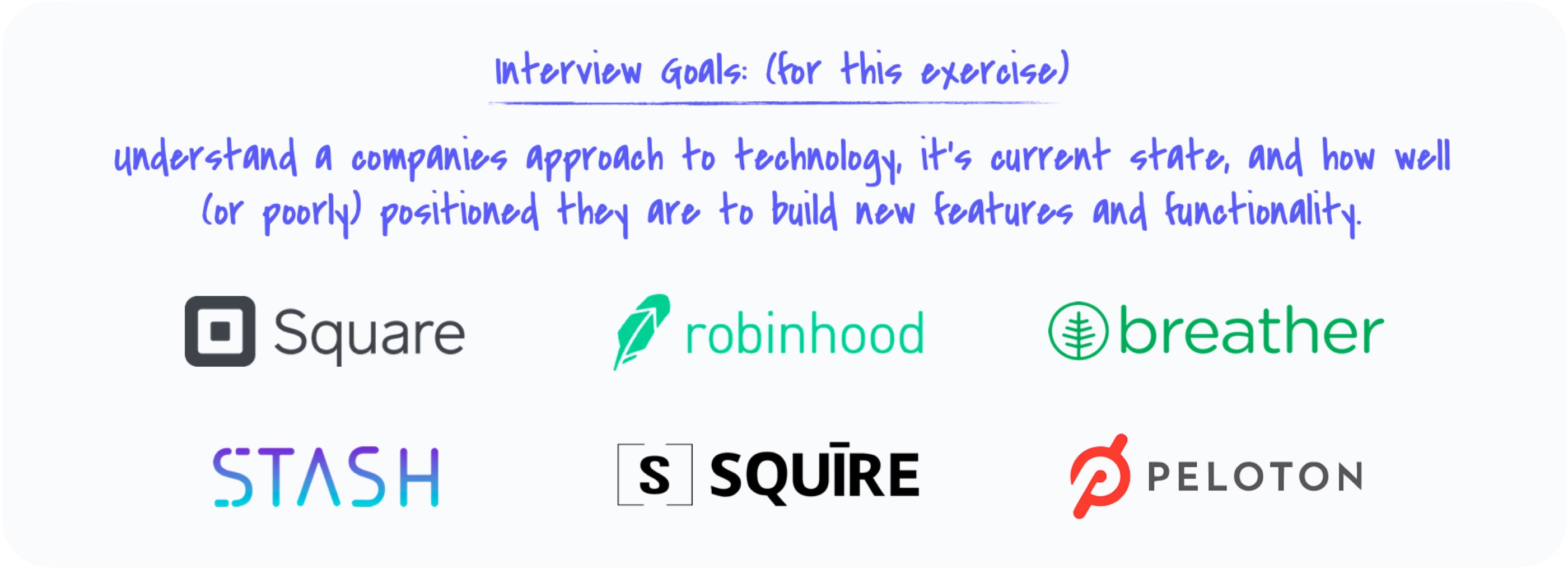
练习3:格式。 (Exercise 3: Format.)
After providing participants with an overview of Analysis Variable 03 (analyzing technology) and walking them through a real-world example of how they can start small to get up and running quickly, ask participants to practice preparing for their own technology analysis via subject matter expert (SME) interviews.
向参与者提供了Analysis Variable 03 (分析技术)的概述并向他们展示了如何从小处着手以快速启动并运行的真实示例之后,请参与者练习通过主题专家进行练习以准备自己的技术分析(SME)面试。
Using the sample interview goal (above) and the interview structure & topic group framework (below), prompt participants to brainstorm a list of topics that they could ask SME’s in order to achieve their research goal.
使用样本访问目标(上面)以及访问结构和主题组框架(下面) ,提示参与者集思广益,讨论可以向中小企业提出的主题列表,以实现他们的研究目标。
- After they have defined a list of topics, prompt participants to identify the top 3 most important topics from their list. 定义主题列表后,提示参与者从列表中识别出最重要的3个主题。
- Next, using their prioritized list of topics, have participants create a short list of questions for each of their 3 prioritized topics. 接下来,让参与者使用他们的优先主题列表,为他们的3个优先主题中的每一个创建简短的问题列表。
- As participants are writing their questions, provide additional information to guide them — remind participants that during an interview they need the facts, but want the the perspective of an interviewee. 在参与者撰写问题时,请提供其他信息以指导他们-提醒参与者在访谈中他们需要事实,但需要受访者的观点。
- To accomplish this, make sure they are asking targeted questions about what a company has/is doing, as well as open-ended questions that enable them to gain a deeper perspective. 要做到这一点,请确保他们正在就公司的经营状况或正在做的事情提出针对性的问题,以及使他们获得更深入了解的开放式问题。

练习3:总结。 (Exercise 3: Wrapping-up.)
After the exercise, prompt participants to spend a few minutes sharing what they learned from brainstorming and writing their SME interview questions and what (if anything) was challenging about the process.
练习后,提示参与者花几分钟时间分享他们从头脑风暴中学习到的知识,并写出他们的SME面试问题,以及对流程有何挑战(如果有的话) 。

练习04 —我确定外部趋势。 (15分钟) (Exercise 04 — identify external trends. (15 mins))
This exercise builds upon the previous exercise, its goal is to practice starting small and getting up and running quickly by conducting a simple analysis of the external trends that are (or will be) impacting a company using information available on the internet and the insights developed during the three previous activities.
本练习是在上一个练习的基础上进行的,其目标是通过使用Internet上可用的信息和开发的见解,通过对可能(或将要影响)公司的外部趋势进行简单分析,来练习从小处着手并快速启动和运行。在之前的三个活动中。
To guide their analysis, participants are provided a sample analysis goal and a set of free resources that can help them get started (see below).
为了指导他们的分析,为参与者提供了一个示例分析目标和一组免费资源,可以帮助他们入门(请参阅下文) 。
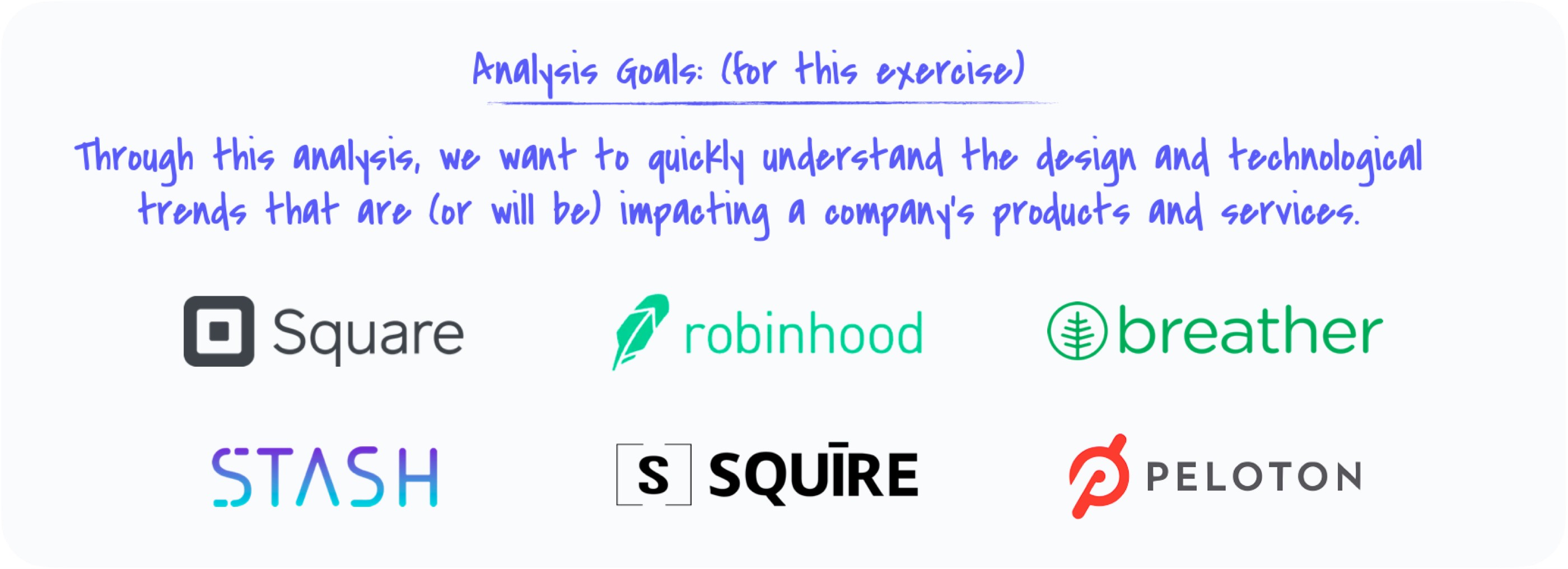
练习4:格式。 (Exercise 4: Format.)
After providing participants with an overview of Analysis Variable 04 (analyzing trends) and walking them through a real-world example of how they can start small to get up and running quickly, ask participants to practice conducting their own lightweight analysis.
向参与者提供了分析变量04的概述(分析趋势),并引导他们完成了一个如何从小处着手以快速启动并快速运行的真实示例之后,请参与者练习进行自己的轻量级分析。
Using the sample analysis goal (above), the free trend resources provided (below), and any relevant insights from previous activities, prompt participants to identify design and technological trends that are impacting a company or it’s products and services.
使用样本分析目标(上) ,提供的免费趋势资源(下)以及先前活动的任何相关见解,可以促使参与者识别影响公司或其产品和服务的设计和技术趋势。
Pro-tip: Start with the free trends reports from Fjord and frog that we discussed earlier.
专家提示:从我们前面讨论的Fjord和frog的免费趋势报告开始。
- As participants identify trends, have them write each one on a separate post-it note. 当参与者识别趋势时,让他们在单独的便条纸上写下每个趋势。
- As they work, remind participants to use what they learned in their previous analysis to identify which trends are relevant to the products and services of the company they are focused on. 在工作时,提醒参与者使用他们在以前的分析中学到的知识,以确定哪些趋势与他们所关注的公司的产品和服务相关。
- To facilitate this, prompt participants using provocations — How modern and tech-forward is the company today? Which of the companies products could benefit from external advances in technology? Which of the companies products could be disrupted by upstart competitors? Why? 为方便起见,请挑衅者使用挑衅行为-今天的公司有多现代和技术进步? 哪些公司的产品可以从外部技术进步中受益? 新贵竞争对手可能会破坏哪些公司的产品? 为什么?
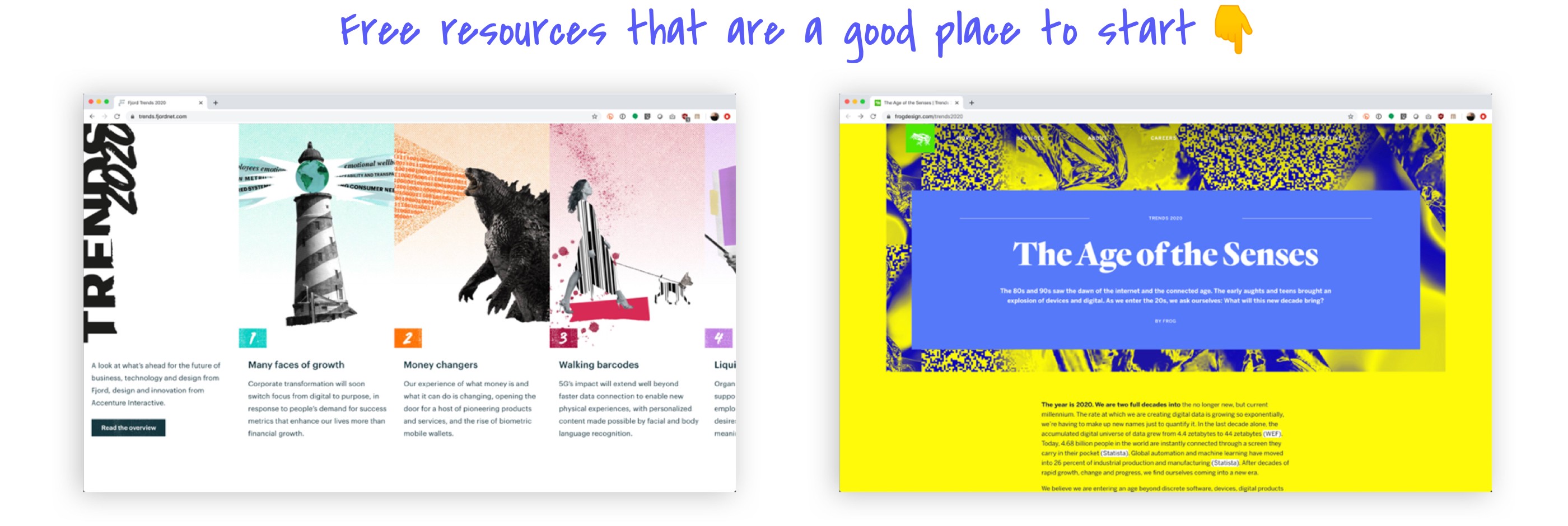
练习4:总结。 (Exercise 4: Wrapping-up.)
After the exercise, prompt participants to spend a few minutes sharing what they learned from conducting their analysis and what (if anything) was challenging about finding, analyzing, and relating information found in trends reports.
练习后,提示参与者花几分钟时间分享他们从进行分析中学到的知识,以及发现,分析和关联趋势报告中的信息所面临的挑战(如果有的话) 。

资源:中小企业面试指南 (Resources: SME interview discussion guide)
The shared resource below can be used as reference when you and your team are planning and conducting a technology-focused subject matter expert (SME) interview.
当您和您的团队计划并进行以技术为重点的主题专家(SME)面试时,下面的共享资源可用作参考。
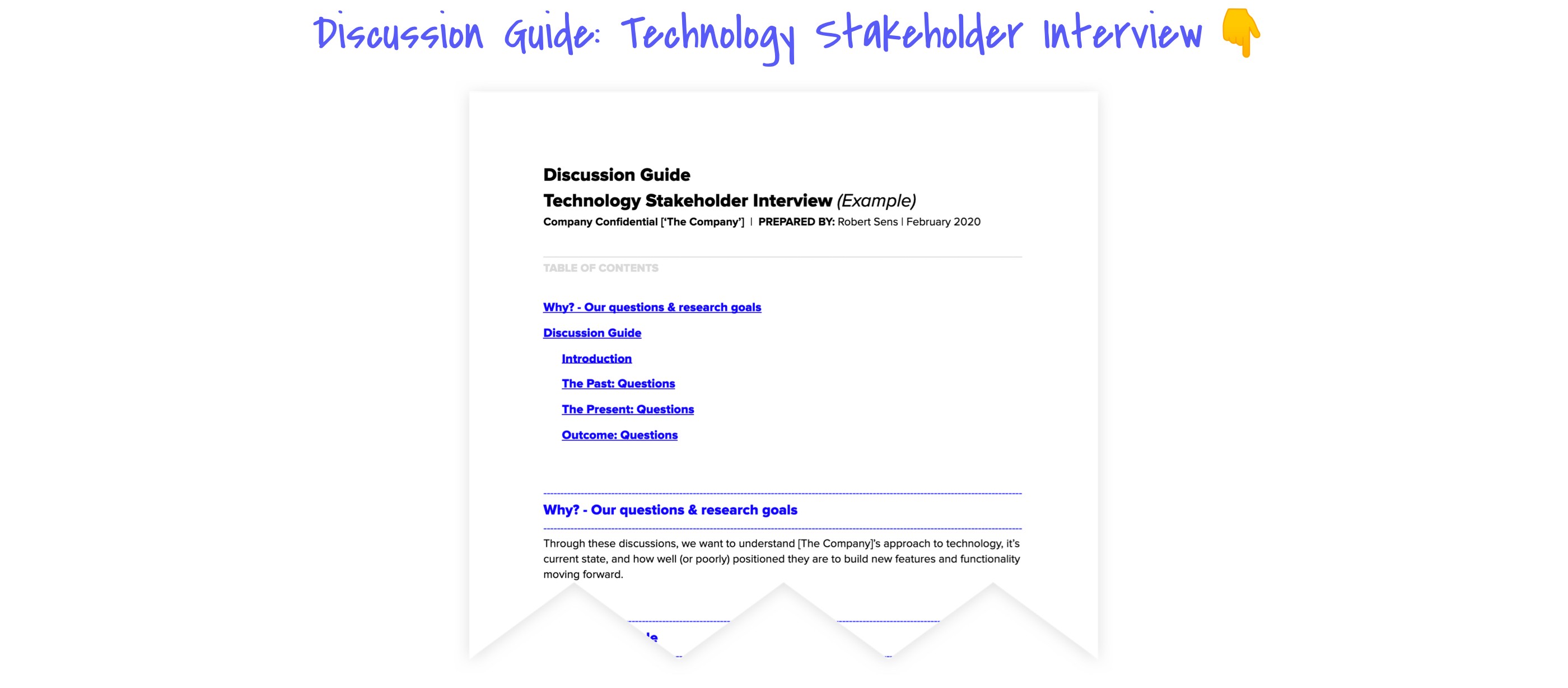
模板01: 讨论指南-技术利益相关者访谈 (Template 01: Discussion guide — technology stakeholder interview)
Editable Google Doc and real-world example that you can use to help plan and facilitate an in-person (or remote) moderated subject matter expert (SME) interview.
您可以使用可编辑的Google Doc和真实示例来帮助计划和促进亲自(或远程)主持的主题专家(SME)面试。
View and download example & editable template
查看和下载示例和可编辑模板

本系列的下一期是什么? (What’s the next session in this series?)
This session is the last session in this curriculum that is specifically focused on user research & customer discovery. Subsequent sessions focus on techniques for using what we have learned about customer behavior to develop and evaluate ideas — specifically synthesis, sense making, ideation, & evaluation.
本节课是本课程中的最后一节,专门针对用户研究和客户发现 。 随后的会议重点讨论了利用我们对客户行为学到的知识来发展和评估想法的技术,特别是综合,理性,构想和评估 。
For additional information on these sessions, please visit: 👇👇🏼👇🏾
有关这些会议的更多信息,请访问: 👇👇🏼👇🏾

下一步是什么? (What’s next?)
Thank you for reading! Over the next few months, I will continue to add detailed session plans for each of the sessions outlined in this curriculum. In the meantime, any and all feedback is appreciated. 💭
感谢您的阅读! 在接下来的几个月中,我将继续为本课程中概述的每个课程添加详细的课程计划。 同时,感谢所有反馈。 💭
翻译自: https://blog.prototypr.io/ux-design-101-uncovering-your-clients-unspoken-needs-360-landscape-analysis-c9ff06a010ba
ux设计
本文来自互联网用户投稿,该文观点仅代表作者本人,不代表本站立场。本站仅提供信息存储空间服务,不拥有所有权,不承担相关法律责任。如若转载,请注明出处:http://www.mzph.cn/news/274165.shtml
如若内容造成侵权/违法违规/事实不符,请联系多彩编程网进行投诉反馈email:809451989@qq.com,一经查实,立即删除!





)











—从图片中获得配色灵感)
